EVLA Spectral Line Calibration IRC+10216: Difference between revisions
| (105 intermediate revisions by 8 users not shown) | |||
| Line 1: | Line 1: | ||
[[Category:EVLA]][[Category:Calibration]][[Category:Spectral Line]] | [[Category:EVLA]][[Category:Calibration]][[Category:Spectral Line]] | ||
== Overview == | |||
[[Image:irc10216_dust.jpg|thumb|VLT V-band image of IRC+10216 showing dust rings out to a radius of 90" by Leão et al. (2006, A&A, 455, 187).]] | |||
This tutorial describes the data reduction for two spectral lines observed toward the AGB star IRC+10216. | |||
In this EVLA OSRO1 mode observation one subband was observed in each of two basebands, the subbands were centered on the HC3N and SiS lines near 36 GHz. The raw data were loaded into CASA with {{importevla}}, where zero and shadowed data were flagged. Then the data were "{{split}}", so we could average from the native 1 second integrations to 10 seconds, select only antennas with Ka-band receivers, and select only spectral windows (called spw in CASA) with Ka-band data. This produces a significantly smaller dataset for processing. | |||
IRC+10216 (CW Leo) is the brightest star in the sky at 5 microns but only 16th magnitude visually. It was discovered during the first survey | |||
of the infrared sky, carried out by Bob Leighton and Gerry Neugebauer in 1965. An Asymptotic Giant Branch star, it is a Mira-type variable going through prodigious episodic mass loss. The dust condensed from the atmosphere during the mass loss is responsible for the millimeter emission; the continuum emission seen at radio wavelengths probes the actual stellar photosphere. Molecules form along with the dust, and a steady state chemistry occurs in the dense inner regions (Tsuji 1973 A&A 23, 411). As the density of material drops, the chemistry freezes. But the molecules continue their long coast outward into the Galaxy, and as the shell thins ultraviolet light from the ambient galactic radiation field penetrates and initiates a new chemistry in the gas. | |||
SiS, a simple molecule created in the dense inner envelope chemistry is photodissociated as it coasts out into the shell. The result is the | |||
centrally condensed emission we see in the present observations. Interestingly, in the next lower transition at 18 GHz, the line shape is | |||
much different from what we see here. At the extreme velocities in the profile, very bright narrow emission is seen which has been interpreted | |||
as maser emission. The interested student can find EVLA observations of this line in the archive. | |||
HC3N, a much more complex species, is created by the photochemistry which becomes active as atoms and pieces of molecules destroyed by | |||
ultraviolet radiation undergo the next phase of chemistry in the shell. HC3N has many vibrational modes which may be excited in addition to | |||
its rotational modes. Owing to this, it can re-radiate energy absorbed from ultraviolet radiation more effectively than some molecules with a | |||
single bond. Eventually it too is destroyed however, but during its brief existence its rise to abundance in the envelope results in a ring of emission, which is what is observed in this image made with the EVLA. A recent model by Cordiner & Millar (2009, ApJ, 697, 68) describes a | |||
new chemical model for the shell, which also takes into account the variation of mass loss by the star. They show that in addition to | |||
purely chemical effects, local gas and dust density peaks play a role in shaping the observed emission. | |||
==Getting the data== | |||
The post-split averaged data can be downloaded from http://casa.nrao.edu/Data/EVLA/IRC10216/day2_TDEM0003_10s_norx.tar.gz | |||
Once the download is complete, unpack the file: | |||
</ | <source lang='bash'> | ||
# in a terminal, outside of CASA: | |||
tar -xzvf day2_TDEM0003_10s_norx.tar.gz | |||
</source> | |||
== How to Use This casaguide== | |||
[[Image:clean.png|thumb|Inputs from one of the clean commands from this tutorial]] | |||
There are a number of possible ways to run CASA. Many aspects are described in [[Getting_Started_in_CASA]]. You should review this page if you are new to CASA. In brief you can run CASA interactively by looking at the inputs to tasks with '''inp taskname''' (example: inp clean), setting the parameters one by one (example: selectdata=T) as you desire and then run '''go'''. After setting parameters one by one in a task and then looking at the inputs again, you will notice that the parameters that have been set to something other than their defaults are blue. If you have mistyped any parameters, they will be red and must be fixed for the task to run correctly. You can get more detailed help on any task by typing '''help taskname''' (example: help clean). Once a task is run you can get the same parameters back by running '''tget taskname''' (example: tget clean); subsequent runs will overwrite the previous tget file. | |||
The second way to run CASA is to provide task function calls. This tutorial is made up of such calls, which were developed by looking at the inputs for each task and deciding what needed to be changed from default values. For task function calls, '''only parameters that you want to be different from their defaults need to be set'''. A series of task function calls can be combined together into a script, and run with '''execfile('scriptname.py')'''. It is possible to extract a script containing all the CASA task function calls in this and other casaguides using the method described at the [[Extracting_scripts_from_these_tutorials]] page. | |||
If you are a relative novice or just new to CASA it is strongly recommended to work through this tutorial by cutting and pasting the task function calls provided below after you have read all the associated explanations. Work at your own pace, look at the inputs to the tasks to see what other options exist, and read the help files. Later, when you are more comfortable, you might try to extract the script, modify it for your purposes, and begin to reduce other data. | |||
== The Observing Log, Antenna Position Corrections, and other Calibration "Priors"== | == The Observing Log, Antenna Position Corrections, and other Calibration "Priors"== | ||
For all EVLA observations, the operators keep an observing log. You can look at | For all EVLA observations, the operators keep an observing log. You can look at | ||
the observing logs at the observing log [[http://www.vla.nrao.edu/cgi-bin/oplogs.cgi website]]. Pertinent information from this observation | the observing logs at the observing log [[http://www.vla.nrao.edu/cgi-bin/oplogs.cgi website]]. Pertinent information from this observation is repeated below. | ||
<pre style="background-color: #E0FFFF;"> | <pre style="background-color: #E0FFFF;"> | ||
INFORMATION FROM OBSERVING LOG: | INFORMATION FROM OBSERVING LOG: | ||
Date of the observation: 26-April-2010 | |||
There are no Ka-band receivers on ea11, ea13, ea14, ea16, ea17, ea18, ea26 | There are no Ka-band receivers on ea11, ea13, ea14, ea16, ea17, ea18, ea26 | ||
Antennas ea10, ea06 are out of the array | Antennas ea10, ea06 are out of the array | ||
| Line 31: | Line 58: | ||
As mentioned in the log, antennas ea10, ea12, and ea22 do not have good baseline positions. | As mentioned in the log, antennas ea10, ea12, and ea22 do not have good baseline positions. | ||
Antenna ea10 was not in the array, but for the other two antennas we need to check for | Antenna ea10 was not in the array, but for the other two antennas we need to check for | ||
any improved baseline positions that were derived after the | any improved baseline positions that were derived after the observations were taken. | ||
In CASA, we need to insert these corrections by hand using '''gencal'''. The resulting table will need to be supplied as a "prior" calibration to all subsequent calibration steps. The corrections can be ascertained from | In CASA, we need to insert these corrections by hand using '''{{gencal}}'''. The resulting table will need to be supplied as a "prior" calibration to all subsequent calibration steps. The corrections can be ascertained from the [http://www.vla.nrao.edu/astro/archive/baselines/ EVLA/VLA Baseline Corrections page]. Be sure to carefully read to the bottom of that | ||
webpage to see how to calculate the additive corrections. In the future we will implement an automated lookup of the corrections. | webpage to see how to calculate the additive corrections. The current case is simple as there is only a single correction for each antenna. In the future we will implement an automated lookup of the corrections. | ||
<source lang="python"> | <source lang="python"> | ||
| Line 41: | Line 67: | ||
gencal(vis='day2_TDEM0003_10s_norx',caltable='antpos.cal', | gencal(vis='day2_TDEM0003_10s_norx',caltable='antpos.cal', | ||
caltype='antpos', | caltype='antpos', | ||
antenna='ea12 | antenna='ea12,ea22', | ||
parameter=[-0.0072,0.0045, -0.0017, -0.0220,0.0040,-0.0190]) | parameter=[-0.0072,0.0045,-0.0017, -0.0220,0.0040,-0.0190]) | ||
</source> | </source> | ||
Please note | '''Please note: '''if you are reducing VLA data taken before March 1, 2010, you need to set caltype='antposvla'. | ||
There are two other types of "priors" that we will need to apply at each calibration stage: | |||
There are two other types of "priors" that we will need to apply at each calibration stage described below: | |||
(1) Opacity correction -- in the near future the opacity will be calculated from the weather | (1) Opacity correction -- in the near future the opacity will be calculated from the weather | ||
data and an atmospheric model, or alternatively from a tipping scan, or a combination of | data and an atmospheric model, or alternatively from a tipping scan, or a combination of | ||
both. For now we use a | both. For now we use a canonical value for the zenith opacity based on the weather on that day, which at this | ||
frequency (36 GHz) is about 0.03 on the best days. We will use a zenith opacity of <math>tau_z</math>=0.04. The zenith opacity is then corrected for | frequency (36 GHz) is about 0.03 on the best days. We will use a zenith opacity of <math>\tau_z</math>=0.04. The zenith opacity is then corrected for | ||
the elevation of the data automatically using <math> e^{[- | the elevation of the data automatically using <math>e^{[-\csc(el)\tau_z]}</math>. | ||
(2) Gaincurve -- the gaincurve describes how each antenna behaves as a function of elevation, for each receiver band. Currently only gaincurves for the VLA/EVLA are available. This option should not be used | |||
(2) Gaincurve -- the gaincurve describes how each antenna behaves as a function of elevation, for each receiver band. | with any other telescopes. | ||
==Initial Inspection and Flagging== | ==Initial Inspection and Flagging== | ||
| Line 113: | Line 141: | ||
18 ea28 N08 25.0 m -107.37.07.5 +33.54.15.8 | 18 ea28 N08 25.0 m -107.37.07.5 +33.54.15.8 | ||
</pre> | </pre> | ||
Note that the Rest Frequency and Systemic Velocity are wrong in the listobs log by a factor 10^6 and 1000, respectively, given the quoted units (MHz) and (km/s). This was due to a temporary error in the EVLA Observing Tool that has subsequently been fixed. Because the sky frequencies are correct, and we set the rest frequency explicitly later in the deconvolution stage, this does not present a problem for the data reductions. | |||
<pre style="background-color: #E0FFFF;"> | <pre style="background-color: #E0FFFF;"> | ||
| Line 135: | Line 165: | ||
</source> | </source> | ||
Next, let's look at the elevation as a function of time for all sources. It's not the case for these data, but if the elevation is very low (usually at start or end of track) you may want to flag. Also, how near in elevation your flux calibrator is to your target will impact your ultimate absolute flux calibration accuracy. Unfortunately, the target and flux calibrator are not particularly well-matched for this observation, as | Next, let's look at the elevation as a function of time for all sources. It's not the case for these data, but if the elevation is very low (usually at start or end of track) you may want to flag. Also, how near in elevation your flux calibrator is to your target will impact your ultimate absolute flux calibration accuracy. Unfortunately, the target and flux calibrator are not particularly well-matched for this observation, as you can show by plotting the elevation for each source (each sources has a different colors): | ||
<source lang="python"> | <source lang="python"> | ||
| Line 143: | Line 171: | ||
plotms(vis='day2_TDEM0003_10s_norx', | plotms(vis='day2_TDEM0003_10s_norx', | ||
xaxis='time',yaxis='elevation',correlation='RR,LL', | xaxis='time',yaxis='elevation',correlation='RR,LL', | ||
avgchannel='64',spw='0:4~60') | avgchannel='64',spw='0:4~60', coloraxis='field') | ||
</source> | </source> | ||
Thus we are strongly dependent on the opacity and gaincurve corrections to get the flux scale right for these data. (This is something to keep in mind when planning observations!) | Thus we are strongly dependent on the opacity and gaincurve corrections to get the flux scale right for these data. (This is something to keep in mind when planning observations!) | ||
[[Image:plotallfields.png|thumb|Result of plotms | [[Image:plotallfields.png|thumb|Result of plotms]] | ||
[[Image:Zoom1_mark.png|thumb|Zooming in and marking region (hatched box)]] | [[Image:Zoom1_mark.png|thumb|Zooming in and marking region (hatched box)]] | ||
Next,let's look at all the source amplitudes as a function of time. | Next, let's look at all the source amplitudes as a function of time. | ||
<source lang="python"> | <source lang="python"> | ||
# In CASA | # In CASA | ||
plotms(vis='day2_TDEM0003_10s_norx', | plotms(vis='day2_TDEM0003_10s_norx', | ||
xaxis='time',yaxis='amp',correlation='RR,LL', | xaxis='time',yaxis='amp',correlation='RR,LL', | ||
avgchannel='64',spw='0:4~60') | avgchannel='64',spw='0:4~60', coloraxis='field') | ||
</source> | </source> | ||
Now zoom in on the region very near zero amplitude for sources J0954+1743 and IRC+10216. To zoom, select the | Now zoom in on the region very near zero amplitude for sources J0954+1743 and IRC+10216. To zoom, select the | ||
Zoom tool in lower left corner of the | Zoom tool in lower left corner of the {{plotms}} GUI, then you can left click to draw a box. | ||
Look for the low values (you may want to zoom a few times to really see the suspect points clearly). Now use the Mark Region and Locate buttons (located along the bottom of the GUI) to see which antenna is causing problems. Since all the "located" baselines include ea12, this is the responsible antenna. | Look for the low values (you may want to zoom a few times to really see the suspect points clearly). Now use the Mark Region and Locate buttons (located along the bottom of the GUI) to see which antenna is causing problems. Since all the "located" baselines include ea12, this is the responsible antenna. | ||
| Line 192: | Line 218: | ||
</pre> | </pre> | ||
Now click the | Now click the clear region button, and then go back to the zoom button to zoom in further to note exactly what the time range is: 03:41:00~04:10:00. | ||
Check the other sideband by changing spw to 1:4~60. You will have to | Check the other sideband by changing spw to 1:4~60. You will have to | ||
| Line 213: | Line 239: | ||
</source> | </source> | ||
Note that because the chosen timerange is limited to fields 2 and 3,the field parameter is not really | Note that because the chosen timerange is limited to fields 2 and 3, the field parameter is not really | ||
needed; however, flagdata will run fastest if you put as many constraints as possible. | needed; however, flagdata will run fastest if you put as many constraints as possible. | ||
| Line 220: | Line 246: | ||
check 3C286 (J1229+0203 is already obvious because it is so bright!). | check 3C286 (J1229+0203 is already obvious because it is so bright!). | ||
[[Image:IRC10216_uvdist1.png|thumb|Amplitude vs. uv-distance for IRC+10216, both spw | [[Image:IRC10216_uvdist1.png|thumb|Amplitude vs. uv-distance for IRC+10216, both spw]] | ||
Lets look more closely at IRC+10216: | Lets look more closely at IRC+10216: | ||
| Line 228: | Line 254: | ||
plotms(vis='day2_TDEM0003_10s_norx',field='3', | plotms(vis='day2_TDEM0003_10s_norx',field='3', | ||
xaxis='time',yaxis='amp',correlation='RR,LL', | xaxis='time',yaxis='amp',correlation='RR,LL', | ||
avgchannel='64',spw='0~1:4~60') | avgchannel='64',spw='0~1:4~60', coloraxis='spw') | ||
</source> | </source> | ||
You can see a | |||
that there are some noisy high points. But now try | that there are some noisy high points. But now try | ||
| Line 238: | Line 264: | ||
plotms(vis='day2_TDEM0003_10s_norx',field='3', | plotms(vis='day2_TDEM0003_10s_norx',field='3', | ||
xaxis='uvdist',yaxis='amp',correlation='RR,LL', | xaxis='uvdist',yaxis='amp',correlation='RR,LL', | ||
avgchannel='64',spw='0~1:4~60') | avgchannel='64',spw='0~1:4~60', coloraxis='spw') | ||
</source> | </source> | ||
Most of the high points on IRC+10216 are due to large scale emission on short baselines, but there is still some noisy stuff -- for a target like this with extended emission | Most of the high points on IRC+10216 are due to large scale emission on short baselines, but there is still some noisy stuff -- for a target like this with extended emission it's best to wait until later to decide what to do about it. We will not be able to get adequate calibration for antennas that are truly bad (even if they don't stand out here) so these will be obvious later. | ||
==Set Up the Model for the Flux Calibrator== | |||
Next, we set the model for the flux calibrator. Depending on your observing frequency and angular resolution you can do this several ways. In the past, one typically used a point source (constant flux) model for | |||
the flux calibrator, possibly with a uvrange cutoff if necessary. More recently for the VLA/EVLA, model images for the most common flux calibrators have been made available for use in cases where the sources are somewhat resolved. This is most likely to be true at higher frequencies and at higher resolutions (more extended arrays). Thus below we use the K-band model image for these Ka-band observations. Because one model image is typically available per receiver band (in this case the model for Ka-band is the same as that of K-band), the frequency of the model image probably does not match exactly the frequency of your observations, as is certainly the case here. In that case, the task scales the total flux in the model image to that appropriate for your observing frequency according to the calibrator's flux as a function of frequency model, and reports this number in the logger -- it is a good idea to save this information for your records. | |||
First, we need to locate the model image. The modimage location used in the command is appropriate for running CASA after installing from the 3.0.2 Linux tarball. If you are running elsewhere (Mac for example), | |||
= | <source lang='bash'> | ||
# in a terminal, outside of CASA: | |||
locate 3C286_K.im | |||
</source> | |||
to find where the models live (the models are always shipped with CASA). For example at the AOC they are located in /usr/lib64/casapy/data/nrao/VLA/CalModels/ for 64-bit computers. If you have just installed CASA your computer's database may not have updated yet. In that case you will need to look around for them. | |||
Once you have found the path to the file, you need to edit the value of the modimage parameter in setjy below. | |||
<source lang="python"> | <source lang="python"> | ||
| Line 255: | Line 293: | ||
<pre style="background-color: #fffacd;"> | <pre style="background-color: #fffacd;"> | ||
The logger output for each spw is: | The logger output for each spw is: | ||
setjy | setjy J1331+3030 spwid= 0 [I=1.776, Q=0, U=0, V=0] Jy, (Perley-Butler 2010) | ||
setjy | setjy J1331+3030 spwid= 1 [I=1.779, Q=0, U=0, V=0] Jy, (Perley-Butler 2010) | ||
</pre> | </pre> | ||
==Bandpass== | ==Bandpass== | ||
| Line 282: | Line 311: | ||
avgtime='1e8',spw='0:4~60',antenna='ea02&ea23') | avgtime='1e8',spw='0:4~60',antenna='ea02&ea23') | ||
</source> | </source> | ||
[[Image:Nobandpass_phase.png|thumb|Phase as a function of channel for ea02 (after | [[Image:Nobandpass_phase.png|thumb|Phase as a function of channel for ea02 (after Custom and upping "Style" to 3.)]] | ||
The phase variation is modest ~10 degrees. Now expand to all | The phase variation is modest ~10 degrees. Now expand to all baselines that include ea02, then hit the "Plot" button. | ||
<source lang="python"> | <source lang="python"> | ||
| Line 290: | Line 318: | ||
plotms(vis='day2_TDEM0003_10s_norx',field='5', | plotms(vis='day2_TDEM0003_10s_norx',field='5', | ||
xaxis='channel',yaxis='phase',correlation='RR', | xaxis='channel',yaxis='phase',correlation='RR', | ||
avgtime='1e8',spw='0:4~60',antenna='ea02') | avgtime='1e8',spw='0:4~60',antenna='ea02', coloraxis='antenna2') | ||
</source> | </source> | ||
[[Image:Nobandpass_phasetime.png|thumb|Phase as a function of time for ea02 (after | [[Image:Nobandpass_phasetime.png|thumb|Phase as a function of time for all baselines with antenna ea02 (after Custom and upping "Style" to 3.)]] | ||
From this | |||
you can see that the phase variation across the bandpass is | you can see that the phase variation across the bandpass is | ||
modest. Next check LL, and spw=1, both correlations. Also check | modest. Next check LL, and spw=1, both correlations. Also check | ||
| Line 314: | Line 342: | ||
plotms(vis='day2_TDEM0003_10s_norx',field='5', | plotms(vis='day2_TDEM0003_10s_norx',field='5', | ||
xaxis='time',yaxis='phase',correlation='RR', | xaxis='time',yaxis='phase',correlation='RR', | ||
avgchannel='64',spw='0:4~60',antenna='ea02') | avgchannel='64',spw='0:4~60',antenna='ea02', coloraxis='antenna2') | ||
</source> | </source> | ||
You may want to select "Custom" under "unflagged points symbol" and then change Style from "2" to "3". | |||
You can see that the phase variations are smooth, but do vary | You can see that the phase variations are smooth, but do vary | ||
| Line 341: | Line 371: | ||
field='5',spw='0~1:20~40', | field='5',spw='0~1:20~40', | ||
refant='ea02',calmode='p',solint='int',minsnr=2.0, | refant='ea02',calmode='p',solint='int',minsnr=2.0, | ||
gaintable=['antpos.cal' | gaintable=['antpos.cal'], | ||
opacity=0.04,gaincurve=T) | opacity=0.04,gaincurve=T) | ||
</source> | </source> | ||
| Line 353: | Line 383: | ||
</source> | </source> | ||
After the first set of plots | These solutions will appear in the CASA plotter gui. If you closed it after plotting the antennas above, it should reopen. If it is still open from before, the new plots should just appear. After you are done looking at the first set of plots, push the "Next" button on the GUI to see the next set of antennas. | ||
GUI to see the next set of antennas. | |||
Next we can apply this phase solution on the fly while determining | Next we can apply this phase solution on the fly while determining | ||
| Line 366: | Line 395: | ||
bandpass(vis='day2_TDEM0003_10s_norx',caltable='bandpass.bcal',field='5', | bandpass(vis='day2_TDEM0003_10s_norx',caltable='bandpass.bcal',field='5', | ||
refant='ea02',solint='inf',solnorm=T, | refant='ea02',solint='inf',solnorm=T, | ||
gaintable=['antpos.cal','bpphase.gcal' | gaintable=['antpos.cal','bpphase.gcal'], | ||
opacity=0.04,gaincurve=T) | opacity=0.04,gaincurve=T) | ||
</source> | </source> | ||
| Line 372: | Line 401: | ||
'''A few words about solint and combine:''' | '''A few words about solint and combine:''' | ||
The use of solint='inf' in | The use of solint='inf' in {{bandpass}} will derive one bandpass | ||
solution for the whole J1229+0203 scan. Note that if there had been two observations of the bandpass calibrator (for example), this command would have combined the data from both scans to form one bandpass solution, because the default of the combine parameter '''for | solution for the whole J1229+0203 scan. Note that if there had been two observations of the bandpass calibrator (for example), this command would have combined the data from both scans to form one bandpass solution, because the default of the combine parameter '''for {{bandpass}}''' is combine='scan'. To solve for one bandpass for each bandpass calibrator scan you would also need to include combine='''' '''' in the bandpass call. In all calibration tasks, regardless of solint, scan boundaries are only crossed when combine='scan'. Likewise, field (spw) boundaries are only crossed if combine='field' (combine='spw'), the latter two are not generally good ideas for bandpass solutions. | ||
Plot the solutions, amplitude and phase: | Plot the solutions, amplitude and phase: | ||
| Line 399: | Line 428: | ||
will overwrite this one, so no need to worry. | will overwrite this one, so no need to worry. | ||
[[Image:Applybandpass_phase.png|thumb|Phase as a function of channel, plotting the corrected data (after | [[Image:Applybandpass_phase.png|thumb|Phase as a function of channel, plotting the corrected data (after Custom and upping "Style" to 3.)]] | ||
<source lang="python"> | <source lang="python"> | ||
applycal(vis='day2_TDEM0003_10s_norx',field='5', | applycal(vis='day2_TDEM0003_10s_norx',field='5', | ||
gaintable=['antpos.cal','bandpass.bcal'], | gaintable=['antpos.cal','bandpass.bcal'], | ||
gainfield=['','5'], | |||
opacity=0.04,gaincurve=T) | opacity=0.04,gaincurve=T,calwt=F) | ||
</source> | </source> | ||
| Line 412: | Line 441: | ||
xaxis='channel',yaxis='phase',ydatacolumn='corrected', | xaxis='channel',yaxis='phase',ydatacolumn='corrected', | ||
correlation='RR', | correlation='RR', | ||
avgtime='1e8',spw='0:4~60',antenna='ea02') | avgtime='1e8',spw='0:4~60',antenna='ea02', coloraxis='antenna2') | ||
</source> | </source> | ||
| Line 419: | Line 448: | ||
xaxis='channel',yaxis='amp',ydatacolumn='corrected', | xaxis='channel',yaxis='amp',ydatacolumn='corrected', | ||
correlation='RR', | correlation='RR', | ||
avgtime='1e8',spw='0:4~60',antenna='ea02') | avgtime='1e8',spw='0:4~60',antenna='ea02', coloraxis='antenna2') | ||
</source> | </source> | ||
| Line 433: | Line 462: | ||
field='2,5,7',spw='0~1:4~60', | field='2,5,7',spw='0~1:4~60', | ||
refant='ea02',calmode='p',solint='int',minsnr=2.0, | refant='ea02',calmode='p',solint='int',minsnr=2.0, | ||
gaintable=['antpos.cal','bandpass.bcal' | gaintable=['antpos.cal','bandpass.bcal'], | ||
opacity=0.04,gaincurve=T) | opacity=0.04,gaincurve=T) | ||
</source> | </source> | ||
| Line 439: | Line 468: | ||
Here solint='int' coupled with calmode='p' will derive a single phase solution for each 10 second integration. Note that the bandpass table is applied on-the-fly before solving for the phase solutions, however the bandpass is NOT applied to the data permanently until applycal is run later on. | Here solint='int' coupled with calmode='p' will derive a single phase solution for each 10 second integration. Note that the bandpass table is applied on-the-fly before solving for the phase solutions, however the bandpass is NOT applied to the data permanently until applycal is run later on. | ||
Note that quite a few solutions are rejected due to SNR<2 (printed to terminal). For the most part it | |||
is only one or two solutions out of >30 so this isn't too worrying. Take note if you see large numbers of rejected solutions per integration. This is likely an indication that solint is too short for the S/N of the data. | |||
Now look at the phase solution, and note the obvious scatter within a scan time. | Now look at the phase solution, and note the obvious scatter within a scan time. | ||
| Line 455: | Line 487: | ||
field='2,5,7',spw='0~1:4~60', | field='2,5,7',spw='0~1:4~60', | ||
refant='ea02',calmode='p',solint='inf',minsnr=2.0, | refant='ea02',calmode='p',solint='inf',minsnr=2.0, | ||
gaintable=['antpos.cal','bandpass.bcal' | gaintable=['antpos.cal','bandpass.bcal'], | ||
opacity=0.04,gaincurve=T) | opacity=0.04,gaincurve=T) | ||
</source> | </source> | ||
| Line 465: | Line 497: | ||
</source> | </source> | ||
Alternatively, one can also run | Note that there are no failed solutions here because of the added S/N afforded by the longer solint. | ||
Alternatively, instead of making a separate phase solution for application to the target, one can also run {{smoothcal}} to smooth the solutions derived on the integration time. | |||
Next we apply the bandpass and solint='int' phase-only calibration solutions on-the-fly to derive amplitude solutions. | Next we apply the bandpass and solint='int' phase-only calibration solutions on-the-fly to derive amplitude solutions. | ||
| Line 475: | Line 508: | ||
field='2,5,7',spw='0~1:4~60', | field='2,5,7',spw='0~1:4~60', | ||
refant='ea02',calmode='ap',solint='inf',minsnr=2.0, | refant='ea02',calmode='ap',solint='inf',minsnr=2.0, | ||
gaintable=['antpos.cal','bandpass.bcal','intphase.gcal' | gaintable=['antpos.cal','bandpass.bcal','intphase.gcal'], | ||
opacity=0.04,gaincurve=T) | opacity=0.04,gaincurve=T) | ||
</source> | </source> | ||
| Line 498: | Line 531: | ||
Note that the amplitude solutions for ea12 are very low; this is another indication that this antenna is dubious. | Note that the amplitude solutions for ea12 are very low; this is another indication that this antenna is dubious. | ||
Next we use the flux calibrator (whose flux density was set in | Next we use the flux calibrator (whose flux density was set in {{setjy}} above) to derive the flux of the other calibrators. Note that the flux table REPLACES the amp.gcal in terms of future application of the calibration to the data, i.e. the flux table contains both the amp.gcal and flux scaling. Unlike the gain calibration steps, this is not an incremental table. | ||
<source lang="python"> | <source lang="python"> | ||
| Line 510: | Line 543: | ||
<pre style="background-color: #fffacd;"> | <pre style="background-color: #fffacd;"> | ||
Flux density for J0954+1743 in SpW=0 | Flux density for J0954+1743 in SpW=0 is: 0.237135 +/- 0.000858511 (SNR = 276.216, nAnt= 19) | ||
Flux density for J0954+1743 in SpW=1 is: 0.247597 +/- 0.00063498 (SNR = 389.928, nAnt= 19) | |||
Flux density for J0954+1743 in SpW=1 | Flux density for J1229+0203 in SpW=0 is: 26.508 +/- 0 (SNR = inf, nAnt= 19) | ||
Flux density for J1229+0203 in SpW=1 is: 26.2517 +/- 0 (SNR = inf, nAnt= 19) | |||
Flux density for J1229+0203 in SpW=0 | |||
Flux density for J1229+0203 in SpW=1 | |||
</pre> | </pre> | ||
Obviously, the signal-to-noise for J1229+0203 can't be infinity! This is just an indication that | Obviously, the signal-to-noise for J1229+0203 can't be infinity! This is just an indication that there is only one scan for this source, and we derived a scan based amplitude solution, so there is no variation to calculate. | ||
Next, check that the flux.cal table looks as expected. | Next, check that the flux.cal table looks as expected. | ||
| Line 533: | Line 563: | ||
Now we apply the calibration to each source, according to which tables are appropriate, and which source should be used to do that particular calibration. For the calibrators, all bandpass solutions come from the bandpass calibrator (id=5), and the phase and amplitude calibration comes from their own solutions. | Now we apply the calibration to each source, according to which tables are appropriate, and which source should be used to do that particular calibration. For the calibrators, all bandpass solutions come from the bandpass calibrator (id=5), and the phase and amplitude calibration comes from their own solutions. | ||
'''Note:''' In applycal we set calwt=F. It is very important to turn off this parameter which determines if the weights are calibrated along with the data. Data from antennas with better receiver performance and/or longer integration times should have higher weights, and it can be advantageous to factor this information into the calibration. During the VLA era, meaningful weights were available for each visibility. However, EVLA is not yet recording the information necessary to calculate meaningful weights. Since these data weights are used at the imaging stage you can get strange results from having calwt=T when the input weights are themselves not meaningful, especially for self-calibration on resolved sources (your flux calibrator and target for example). In a few months EVLA data will again have meaningful weights and the default calwt=T will likely again be the best option. | |||
<source lang="python"> | <source lang="python"> | ||
| Line 538: | Line 570: | ||
applycal(vis='day2_TDEM0003_10s_norx',field='2', | applycal(vis='day2_TDEM0003_10s_norx',field='2', | ||
gaintable=['antpos.cal','bandpass.bcal','intphase.gcal','flux.cal'], | gaintable=['antpos.cal','bandpass.bcal','intphase.gcal','flux.cal'], | ||
gainfield=['','5','2','2'], | |||
opacity=0.04,gaincurve=T) | opacity=0.04,gaincurve=T,calwt=F) | ||
</source> | </source> | ||
| Line 546: | Line 578: | ||
applycal(vis='day2_TDEM0003_10s_norx',field='5', | applycal(vis='day2_TDEM0003_10s_norx',field='5', | ||
gaintable=['antpos.cal','bandpass.bcal','intphase.gcal','flux.cal'], | gaintable=['antpos.cal','bandpass.bcal','intphase.gcal','flux.cal'], | ||
gainfield=['','5','5','5'], | |||
opacity=0.04,gaincurve=T) | opacity=0.04,gaincurve=T,calwt=F) | ||
</source> | </source> | ||
| Line 554: | Line 586: | ||
applycal(vis='day2_TDEM0003_10s_norx',field='7', | applycal(vis='day2_TDEM0003_10s_norx',field='7', | ||
gaintable=['antpos.cal','bandpass.bcal','intphase.gcal','flux.cal'], | gaintable=['antpos.cal','bandpass.bcal','intphase.gcal','flux.cal'], | ||
gainfield=['','5','7','7'], | |||
opacity=0.04,gaincurve=T) | opacity=0.04,gaincurve=T,calwt=F) | ||
</source> | </source> | ||
| Line 564: | Line 596: | ||
applycal(vis='day2_TDEM0003_10s_norx',field='3', | applycal(vis='day2_TDEM0003_10s_norx',field='3', | ||
gaintable=['antpos.cal','bandpass.bcal','scanphase.gcal','flux.cal'], | gaintable=['antpos.cal','bandpass.bcal','scanphase.gcal','flux.cal'], | ||
gainfield=['','5','2','2'], | |||
opacity=0.04,gaincurve=T) | opacity=0.04,gaincurve=T,calwt=F) | ||
</source> | </source> | ||
| Line 574: | Line 606: | ||
plotms(vis='day2_TDEM0003_10s_norx',field='5',ydatacolumn='corrected', | plotms(vis='day2_TDEM0003_10s_norx',field='5',ydatacolumn='corrected', | ||
xaxis='time',yaxis='amp',correlation='RR,LL', | xaxis='time',yaxis='amp',correlation='RR,LL', | ||
avgchannel='64',spw='0:4~60',antenna='') | avgchannel='64',spw='0:4~60',antenna='', coloraxis='antenna1') | ||
</source> | </source> | ||
| Line 584: | Line 616: | ||
plotms(vis='day2_TDEM0003_10s_norx',field='2',ydatacolumn='corrected', | plotms(vis='day2_TDEM0003_10s_norx',field='2',ydatacolumn='corrected', | ||
xaxis='time',yaxis='amp',correlation='RR,LL', | xaxis='time',yaxis='amp',correlation='RR,LL', | ||
avgchannel='64',spw='0:4~60',antenna='') | avgchannel='64',spw='0:4~60',antenna='', coloraxis='antenna2') | ||
</source> | </source> | ||
Here we see some problems, with high points. Mark some regions | Here we see some problems, with high points. Mark some regions | ||
and locate in | and locate in {{plotms}} to find out which antennas and in which spws. Pay special | ||
attention to antennas that have been called out already as showing some dubious behavior. | attention to antennas that have been called out already as showing some dubious behavior. | ||
| Line 600: | Line 632: | ||
plotms(vis='day2_TDEM0003_10s_norx',field='2',ydatacolumn='corrected', | plotms(vis='day2_TDEM0003_10s_norx',field='2',ydatacolumn='corrected', | ||
xaxis='time',yaxis='amp',correlation='RR,LL', | xaxis='time',yaxis='amp',correlation='RR,LL', | ||
avgchannel='64',spw='0:4~60',antenna='ea12') | avgchannel='64',spw='0:4~60',antenna='ea12', coloraxis='antenna2') | ||
</source> | </source> | ||
| Line 606: | Line 638: | ||
plotms(vis='day2_TDEM0003_10s_norx',field='2',ydatacolumn='corrected', | plotms(vis='day2_TDEM0003_10s_norx',field='2',ydatacolumn='corrected', | ||
xaxis='time',yaxis='amp',correlation='RR,LL', | xaxis='time',yaxis='amp',correlation='RR,LL', | ||
avgchannel='64',spw='0:4~60',antenna='ea23') | avgchannel='64',spw='0:4~60',antenna='ea23', coloraxis='antenna2') | ||
</source> | </source> | ||
ea12 needs to be flagged completely its just a bit noisy all around and ea23 is pretty noisy during the first scans between initial and second pointing. Recall that these are antennas we became suspicious of while inspecting the calibration solutions. | ea12 needs to be flagged completely its just a bit noisy all around and ea23 is pretty noisy during the first scans between initial and second pointing. Recall that these are antennas we became suspicious of while inspecting the calibration solutions. | ||
[[Image:target_uvdist.png|thumb|IRC+ | [[Image:target_uvdist.png|thumb|IRC+10216 as a function of uv-distance.]] | ||
Now lets see how the target looks. Because the target has resolved structure, its best to look at it as | Now lets see how the target looks. Because the target has resolved structure, its best to look at it as | ||
a function of uvdistance. We'll go ahead and exclude the three antennas we already know have problems. | a function of uvdistance. We'll go ahead and exclude the three antennas we already know have problems. | ||
| Line 619: | Line 651: | ||
plotms(vis='day2_TDEM0003_10s_norx',field='3',ydatacolumn='corrected', | plotms(vis='day2_TDEM0003_10s_norx',field='3',ydatacolumn='corrected', | ||
xaxis='uvdist',yaxis='amp',correlation='RR,LL', | xaxis='uvdist',yaxis='amp',correlation='RR,LL', | ||
avgchannel='64',spw='0:4~60',antenna='!ea07;!ea12;!ea23') | avgchannel='64',spw='0:4~60',antenna='!ea07;!ea12;!ea23', coloraxis='antenna2') | ||
</source> | </source> | ||
you can see that the spikes | |||
are caused by a single antenna. Use, zoom, mark, and locate to see which one. | are caused by a single antenna. Use, zoom, mark, and locate to see which one. | ||
Also look at spw=1. | Also look at spw=1. | ||
| Line 632: | Line 664: | ||
plotms(vis='day2_TDEM0003_10s_norx',field='3',ydatacolumn='corrected', | plotms(vis='day2_TDEM0003_10s_norx',field='3',ydatacolumn='corrected', | ||
xaxis='uvdist',yaxis='amp',correlation='RR,LL', | xaxis='uvdist',yaxis='amp',correlation='RR,LL', | ||
avgchannel='64',spw='0:4~60',antenna='!ea07;!ea12;!ea23;!ea28') | avgchannel='64',spw='0:4~60',antenna='!ea07;!ea12;!ea23;!ea28', coloraxis='antenna2') | ||
</source> | </source> | ||
| Line 641: | Line 673: | ||
plotms(vis='day2_TDEM0003_10s_norx',field='3',ydatacolumn='corrected', | plotms(vis='day2_TDEM0003_10s_norx',field='3',ydatacolumn='corrected', | ||
xaxis='time',yaxis='amp',correlation='RR,LL', | xaxis='time',yaxis='amp',correlation='RR,LL', | ||
avgchannel='64',spw='0:4~60',antenna='ea28') | avgchannel='64',spw='0:4~60',antenna='ea28', coloraxis='antenna1') | ||
</source> | </source> | ||
| Line 670: | Line 702: | ||
field='5',spw='0~1:20~40', | field='5',spw='0~1:20~40', | ||
refant='ea02',calmode='p',solint='int',minsnr=2.0, | refant='ea02',calmode='p',solint='int',minsnr=2.0, | ||
gaintable=['antpos.cal'], | |||
opacity=0.04,gaincurve=T) | opacity=0.04,gaincurve=T) | ||
</source> | </source> | ||
| Line 678: | Line 711: | ||
field='5', | field='5', | ||
refant='ea02',solint='inf',solnorm=T, | refant='ea02',solint='inf',solnorm=T, | ||
gaintable=['bpphase_redo.gcal' | gaintable=['antpos.cal','bpphase_redo.gcal'], | ||
opacity=0.04,gaincurve=T) | opacity=0.04,gaincurve=T) | ||
</source> | </source> | ||
| Line 687: | Line 720: | ||
field='2,5,7',spw='0~1:4~60', | field='2,5,7',spw='0~1:4~60', | ||
refant='ea02',calmode='p',solint='int',minsnr=2.0, | refant='ea02',calmode='p',solint='int',minsnr=2.0, | ||
gaintable=['antpos.cal','bandpass_redo.bcal' | gaintable=['antpos.cal','bandpass_redo.bcal'], | ||
opacity=0.04,gaincurve=T) | opacity=0.04,gaincurve=T) | ||
</source> | </source> | ||
| Line 696: | Line 729: | ||
field='2,5,7',spw='0~1:4~60', | field='2,5,7',spw='0~1:4~60', | ||
refant='ea02',calmode='p',solint='inf',minsnr=2.0, | refant='ea02',calmode='p',solint='inf',minsnr=2.0, | ||
gaintable=['antpos.cal','bandpass_redo.bcal' | gaintable=['antpos.cal','bandpass_redo.bcal'], | ||
opacity=0.04,gaincurve=T) | opacity=0.04,gaincurve=T) | ||
</source> | </source> | ||
| Line 706: | Line 739: | ||
refant='ea02',calmode='ap',solint='inf',minsnr=2.0, | refant='ea02',calmode='ap',solint='inf',minsnr=2.0, | ||
gaintable=['antpos.cal','bandpass_redo.bcal','intphase_redo.gcal'], | gaintable=['antpos.cal','bandpass_redo.bcal','intphase_redo.gcal'], | ||
opacity=0.04,gaincurve=T) | opacity=0.04,gaincurve=T) | ||
</source> | </source> | ||
| Line 717: | Line 749: | ||
<pre style="background-color: #fffacd;"> | <pre style="background-color: #fffacd;"> | ||
Flux density for J0954+1743 in SpW=0 is: 0. | Flux density for J0954+1743 in SpW=0 is: 0.235345 +/- 0.000879422 | ||
Flux density for J0954+1743 in SpW=1 is: 0. | (SNR = 267.613, nAnt= 16) | ||
Flux density for J1229+0203 in SpW=0 is: | Flux density for J0954+1743 in SpW=1 is: 0.241996 +/- 0.000930228 | ||
Flux density for J1229+0203 in SpW=1 is: | (SNR = 260.147, nAnt= 16) | ||
Flux density for J1229+0203 in SpW=0 is: 25.2479 +/- 0 | |||
(SNR = inf, nAnt= 16) | |||
Flux density for J1229+0203 in SpW=1 is: 24.9907 +/- 0 | |||
(SNR = inf, nAnt= 16) | |||
Flux density for J0954+1743 in SpW=0 is: 0.247052 +/- 0.000946345 (SNR = 261.059, nAnt= 16) | |||
Flux density for J0954+1743 in SpW=1 is: 0.254038 +/- 0.00097531 (SNR = 260.47, nAnt= 16) | |||
Flux density for J1229+0203 in SpW=0 is: 26.5079 +/- 0 (SNR = inf, nAnt= 16) | |||
Flux density for J1229+0203 in SpW=1 is: 26.2335 +/- 0 (SNR = inf, nAnt= 16) | |||
</pre> | </pre> | ||
| Line 733: | Line 774: | ||
applycal(vis='day2_TDEM0003_10s_norx',field='2', | applycal(vis='day2_TDEM0003_10s_norx',field='2', | ||
gaintable=['antpos.cal','bandpass_redo.bcal','intphase_redo.gcal','flux_redo.cal'], | gaintable=['antpos.cal','bandpass_redo.bcal','intphase_redo.gcal','flux_redo.cal'], | ||
gainfield=['','5','2','2'], | |||
opacity=0.04,gaincurve=T) | opacity=0.04,gaincurve=T,calwt=F) | ||
</source> | </source> | ||
| Line 741: | Line 782: | ||
applycal(vis='day2_TDEM0003_10s_norx',field='5', | applycal(vis='day2_TDEM0003_10s_norx',field='5', | ||
gaintable=['antpos.cal','bandpass_redo.bcal','intphase_redo.gcal','flux_redo.cal'], | gaintable=['antpos.cal','bandpass_redo.bcal','intphase_redo.gcal','flux_redo.cal'], | ||
gainfield=['','5','5','5'], | |||
opacity=0.04,gaincurve=T) | opacity=0.04,gaincurve=T,calwt=F) | ||
</source> | </source> | ||
<source lang="python"> | <source lang="python"> | ||
# In CASA | # In CASA | ||
applycal(vis='day2_TDEM0003_10s_norx',field='7', | applycal(vis='day2_TDEM0003_10s_norx',field='7', | ||
gaintable=['antpos.cal','bandpass_redo.bcal','intphase_redo.gcal','flux_redo.cal'], | gaintable=['antpos.cal','bandpass_redo.bcal','intphase_redo.gcal','flux_redo.cal'], | ||
gainfield=['','5','7','7'], | |||
opacity=0.04,gaincurve=T) | opacity=0.04,gaincurve=T,calwt=F) | ||
</source> | </source> | ||
[[Image:gaincal_corrflag.png|thumb|Gain calibrator after further flagging and recalibration]] | |||
[[Image:target_corrflag.png|thumb|IRC+10216 after further flagging and recalibration (after selecting colorize by spw).]] | |||
<source lang="python"> | <source lang="python"> | ||
| Line 758: | Line 801: | ||
applycal(vis='day2_TDEM0003_10s_norx',field='3', | applycal(vis='day2_TDEM0003_10s_norx',field='3', | ||
gaintable=['antpos.cal','bandpass_redo.bcal','scanphase_redo.gcal','flux_redo.cal'], | gaintable=['antpos.cal','bandpass_redo.bcal','scanphase_redo.gcal','flux_redo.cal'], | ||
gainfield=['','5','2','2'], | |||
opacity=0.04,gaincurve=T) | opacity=0.04,gaincurve=T,calwt=F) | ||
</source> | </source> | ||
| Line 768: | Line 811: | ||
plotms(vis='day2_TDEM0003_10s_norx',field='2',ydatacolumn='corrected', | plotms(vis='day2_TDEM0003_10s_norx',field='2',ydatacolumn='corrected', | ||
xaxis='time',yaxis='amp',correlation='RR,LL', | xaxis='time',yaxis='amp',correlation='RR,LL', | ||
avgchannel='64',spw='0:4~60',antenna='') | avgchannel='64',spw='0:4~60',antenna='', coloraxis='antenna2') | ||
</source> | </source> | ||
You can use the Mark and Locate buttons to assess that the remaining scatter seems random, i.e. no particular antenna or time range appears to be responsible. | |||
<source lang="python"> | <source lang="python"> | ||
| Line 777: | Line 820: | ||
plotms(vis='day2_TDEM0003_10s_norx',field='3',ydatacolumn='corrected', | plotms(vis='day2_TDEM0003_10s_norx',field='3',ydatacolumn='corrected', | ||
xaxis='uvdist',yaxis='amp',correlation='RR,LL', | xaxis='uvdist',yaxis='amp',correlation='RR,LL', | ||
avgchannel='64',spw='0~1:4~60',antenna='') | avgchannel='64',spw='0~1:4~60',antenna='', coloraxis='spw') | ||
</source> | </source> | ||
| Line 815: | Line 858: | ||
[[Main Page | ↵ '''CASAguides''']] | [[Main Page | ↵ '''CASAguides''']] | ||
--[[User:Cbrogan|Crystal Brogan]] | --[[User:Cbrogan|Crystal Brogan]] | ||
{{Checked 3.2.0}} | |||
Latest revision as of 18:11, 21 May 2012
Overview
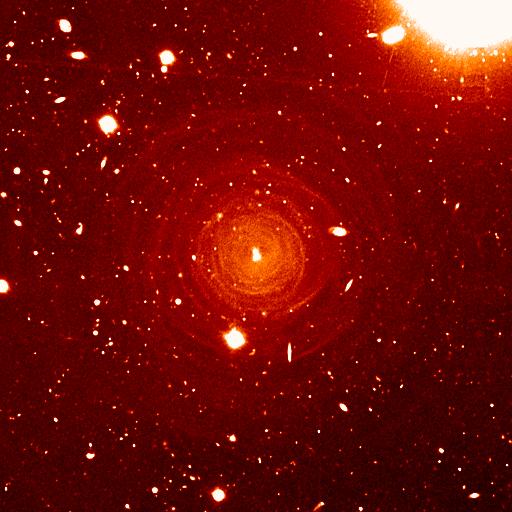
This tutorial describes the data reduction for two spectral lines observed toward the AGB star IRC+10216. In this EVLA OSRO1 mode observation one subband was observed in each of two basebands, the subbands were centered on the HC3N and SiS lines near 36 GHz. The raw data were loaded into CASA with importevla, where zero and shadowed data were flagged. Then the data were "split", so we could average from the native 1 second integrations to 10 seconds, select only antennas with Ka-band receivers, and select only spectral windows (called spw in CASA) with Ka-band data. This produces a significantly smaller dataset for processing.
IRC+10216 (CW Leo) is the brightest star in the sky at 5 microns but only 16th magnitude visually. It was discovered during the first survey of the infrared sky, carried out by Bob Leighton and Gerry Neugebauer in 1965. An Asymptotic Giant Branch star, it is a Mira-type variable going through prodigious episodic mass loss. The dust condensed from the atmosphere during the mass loss is responsible for the millimeter emission; the continuum emission seen at radio wavelengths probes the actual stellar photosphere. Molecules form along with the dust, and a steady state chemistry occurs in the dense inner regions (Tsuji 1973 A&A 23, 411). As the density of material drops, the chemistry freezes. But the molecules continue their long coast outward into the Galaxy, and as the shell thins ultraviolet light from the ambient galactic radiation field penetrates and initiates a new chemistry in the gas.
SiS, a simple molecule created in the dense inner envelope chemistry is photodissociated as it coasts out into the shell. The result is the centrally condensed emission we see in the present observations. Interestingly, in the next lower transition at 18 GHz, the line shape is much different from what we see here. At the extreme velocities in the profile, very bright narrow emission is seen which has been interpreted as maser emission. The interested student can find EVLA observations of this line in the archive.
HC3N, a much more complex species, is created by the photochemistry which becomes active as atoms and pieces of molecules destroyed by ultraviolet radiation undergo the next phase of chemistry in the shell. HC3N has many vibrational modes which may be excited in addition to its rotational modes. Owing to this, it can re-radiate energy absorbed from ultraviolet radiation more effectively than some molecules with a single bond. Eventually it too is destroyed however, but during its brief existence its rise to abundance in the envelope results in a ring of emission, which is what is observed in this image made with the EVLA. A recent model by Cordiner & Millar (2009, ApJ, 697, 68) describes a new chemical model for the shell, which also takes into account the variation of mass loss by the star. They show that in addition to purely chemical effects, local gas and dust density peaks play a role in shaping the observed emission.
Getting the data
The post-split averaged data can be downloaded from http://casa.nrao.edu/Data/EVLA/IRC10216/day2_TDEM0003_10s_norx.tar.gz
Once the download is complete, unpack the file:
# in a terminal, outside of CASA:
tar -xzvf day2_TDEM0003_10s_norx.tar.gz
How to Use This casaguide
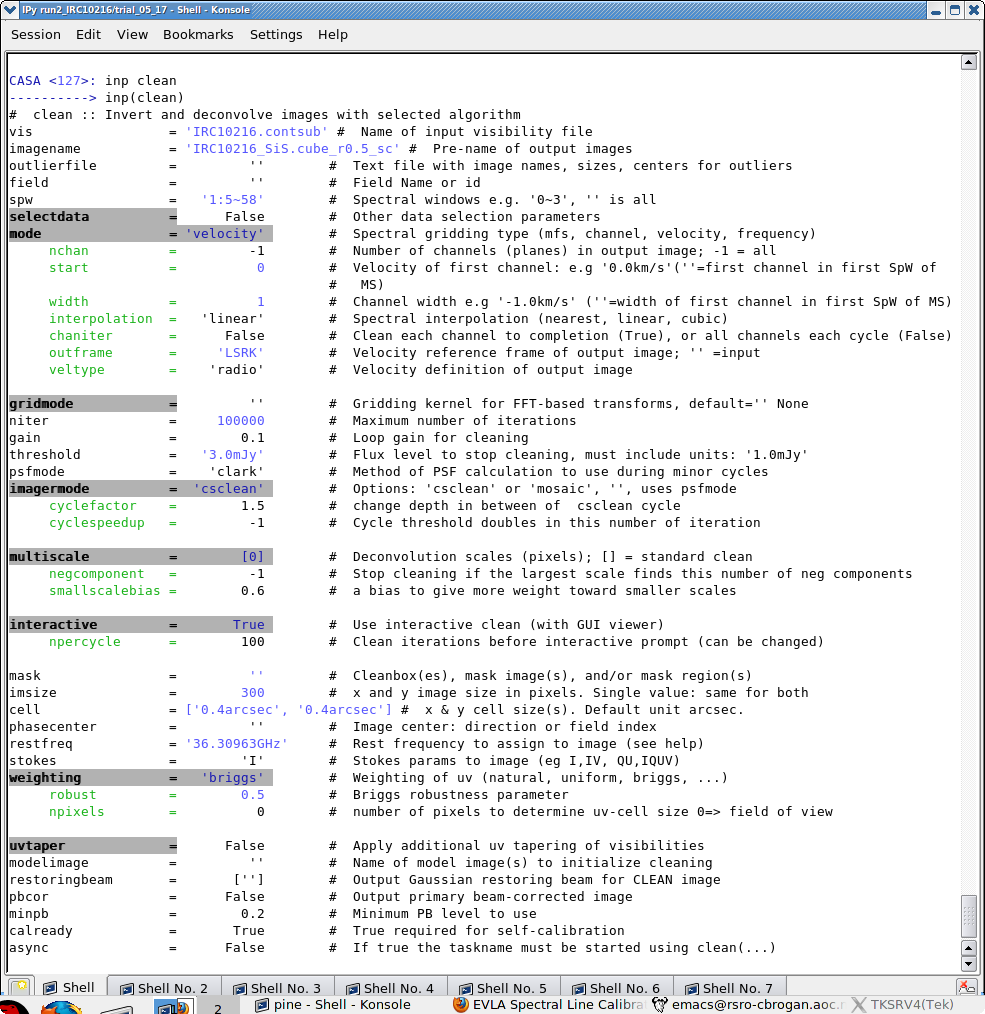
There are a number of possible ways to run CASA. Many aspects are described in Getting_Started_in_CASA. You should review this page if you are new to CASA. In brief you can run CASA interactively by looking at the inputs to tasks with inp taskname (example: inp clean), setting the parameters one by one (example: selectdata=T) as you desire and then run go. After setting parameters one by one in a task and then looking at the inputs again, you will notice that the parameters that have been set to something other than their defaults are blue. If you have mistyped any parameters, they will be red and must be fixed for the task to run correctly. You can get more detailed help on any task by typing help taskname (example: help clean). Once a task is run you can get the same parameters back by running tget taskname (example: tget clean); subsequent runs will overwrite the previous tget file.
The second way to run CASA is to provide task function calls. This tutorial is made up of such calls, which were developed by looking at the inputs for each task and deciding what needed to be changed from default values. For task function calls, only parameters that you want to be different from their defaults need to be set. A series of task function calls can be combined together into a script, and run with execfile('scriptname.py'). It is possible to extract a script containing all the CASA task function calls in this and other casaguides using the method described at the Extracting_scripts_from_these_tutorials page.
If you are a relative novice or just new to CASA it is strongly recommended to work through this tutorial by cutting and pasting the task function calls provided below after you have read all the associated explanations. Work at your own pace, look at the inputs to the tasks to see what other options exist, and read the help files. Later, when you are more comfortable, you might try to extract the script, modify it for your purposes, and begin to reduce other data.
The Observing Log, Antenna Position Corrections, and other Calibration "Priors"
For all EVLA observations, the operators keep an observing log. You can look at the observing logs at the observing log [website]. Pertinent information from this observation is repeated below.
INFORMATION FROM OBSERVING LOG: Date of the observation: 26-April-2010 There are no Ka-band receivers on ea11, ea13, ea14, ea16, ea17, ea18, ea26 Antennas ea10, ea06 are out of the array Antenna ea12 is newly back The pointing is often bad on ea15 Antennas ea10, ea12, ea22 do not have good baseline positions
As mentioned in the log, antennas ea10, ea12, and ea22 do not have good baseline positions. Antenna ea10 was not in the array, but for the other two antennas we need to check for any improved baseline positions that were derived after the observations were taken.
In CASA, we need to insert these corrections by hand using gencal. The resulting table will need to be supplied as a "prior" calibration to all subsequent calibration steps. The corrections can be ascertained from the EVLA/VLA Baseline Corrections page. Be sure to carefully read to the bottom of that webpage to see how to calculate the additive corrections. The current case is simple as there is only a single correction for each antenna. In the future we will implement an automated lookup of the corrections.
# In CASA
gencal(vis='day2_TDEM0003_10s_norx',caltable='antpos.cal',
caltype='antpos',
antenna='ea12,ea22',
parameter=[-0.0072,0.0045,-0.0017, -0.0220,0.0040,-0.0190])
Please note: if you are reducing VLA data taken before March 1, 2010, you need to set caltype='antposvla'.
There are two other types of "priors" that we will need to apply at each calibration stage described below:
(1) Opacity correction -- in the near future the opacity will be calculated from the weather data and an atmospheric model, or alternatively from a tipping scan, or a combination of both. For now we use a canonical value for the zenith opacity based on the weather on that day, which at this frequency (36 GHz) is about 0.03 on the best days. We will use a zenith opacity of [math]\displaystyle{ \tau_z }[/math]=0.04. The zenith opacity is then corrected for the elevation of the data automatically using [math]\displaystyle{ e^{[-\csc(el)\tau_z]} }[/math].
(2) Gaincurve -- the gaincurve describes how each antenna behaves as a function of elevation, for each receiver band. Currently only gaincurves for the VLA/EVLA are available. This option should not be used with any other telescopes.
Initial Inspection and Flagging
# In CASA
listobs(vis='day2_TDEM0003_10s_norx')
Below we have cut and pasted the most relevant output from the logger.
Fields: 4 ID Code Name RA Decl Epoch SrcId nVis 2 D J0954+1743 09:54:56.8236 +17.43.31.2224 J2000 2 65326 3 NONE IRC+10216 09:47:57.3820 +13.16.40.6600 J2000 3 208242 5 F J1229+0203 12:29:06.6997 +02.03.08.5982 J2000 5 10836 7 E J1331+3030 13:31:08.2880 +30.30.32.9589 J2000 7 5814 (nVis = Total number of time/baseline visibilities per field) Spectral Windows: (2 unique spectral windows and 1 unique polarization setups) SpwID #Chans Frame Ch1(MHz) ChanWid(kHz)TotBW(kHz) Ref(MHz) Corrs 0 64 TOPO 36387.2295 125 8000 36387.2295 RR RL LR LL 1 64 TOPO 36304.542 125 8000 36304.542 RR RL LR LL Sources: 10 ID Name SpwId RestFreq(MHz) SysVel(km/s) 0 J1008+0730 0 0.03639232 -0.026 0 J1008+0730 1 0.03639232 -0.026 2 J0954+1743 0 0.03639232 -0.026 2 J0954+1743 1 0.03639232 -0.026 3 IRC+10216 0 0.03639232 -0.026 3 IRC+10216 1 0.03639232 -0.026 5 J1229+0203 0 0.03639232 -0.026 5 J1229+0203 1 0.03639232 -0.026 7 J1331+3030 0 0.03639232 -0.026 7 J1331+3030 1 0.03639232 -0.026 Antennas: 19: ID Name Station Diam. Long. Lat. 0 ea01 W09 25.0 m -107.37.25.2 +33.53.51.0 1 ea02 E02 25.0 m -107.37.04.4 +33.54.01.1 2 ea03 E09 25.0 m -107.36.45.1 +33.53.53.6 3 ea04 W01 25.0 m -107.37.05.9 +33.54.00.5 4 ea05 W08 25.0 m -107.37.21.6 +33.53.53.0 5 ea07 N06 25.0 m -107.37.06.9 +33.54.10.3 6 ea08 N01 25.0 m -107.37.06.0 +33.54.01.8 7 ea09 E06 25.0 m -107.36.55.6 +33.53.57.7 8 ea12 E08 25.0 m -107.36.48.9 +33.53.55.1 9 ea15 W06 25.0 m -107.37.15.6 +33.53.56.4 10 ea19 W04 25.0 m -107.37.10.8 +33.53.59.1 11 ea20 N05 25.0 m -107.37.06.7 +33.54.08.0 12 ea21 E01 25.0 m -107.37.05.7 +33.53.59.2 13 ea22 N04 25.0 m -107.37.06.5 +33.54.06.1 14 ea23 E07 25.0 m -107.36.52.4 +33.53.56.5 15 ea24 W05 25.0 m -107.37.13.0 +33.53.57.8 16 ea25 N02 25.0 m -107.37.06.2 +33.54.03.5 17 ea27 E03 25.0 m -107.37.02.8 +33.54.00.5 18 ea28 N08 25.0 m -107.37.07.5 +33.54.15.8
Note that the Rest Frequency and Systemic Velocity are wrong in the listobs log by a factor 10^6 and 1000, respectively, given the quoted units (MHz) and (km/s). This was due to a temporary error in the EVLA Observing Tool that has subsequently been fixed. Because the sky frequencies are correct, and we set the rest frequency explicitly later in the deconvolution stage, this does not present a problem for the data reductions.
Summary of Observing Strategy Gain Calibrator: J0954+1743 field id=2 Bandpass Calibrator: J1229+0203 field id=5 Flux Calibrator: J1331+3030 (3C286) field id=7 Target: IRC+10216 field id=3 Ka-band spws = 0,1
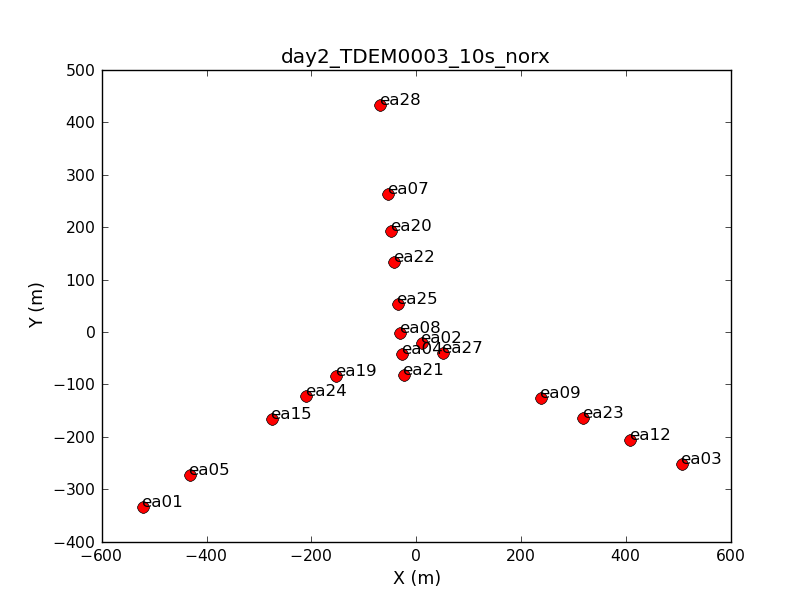
Look at a graphical plot of the antenna locations and save hardcopy in case you want it later. This will be useful for picking a reference antenna -- typically a good choice is an antenna close to the center of the array. Unless it shows problems after inspection of the data, we provisionally chose ea02.
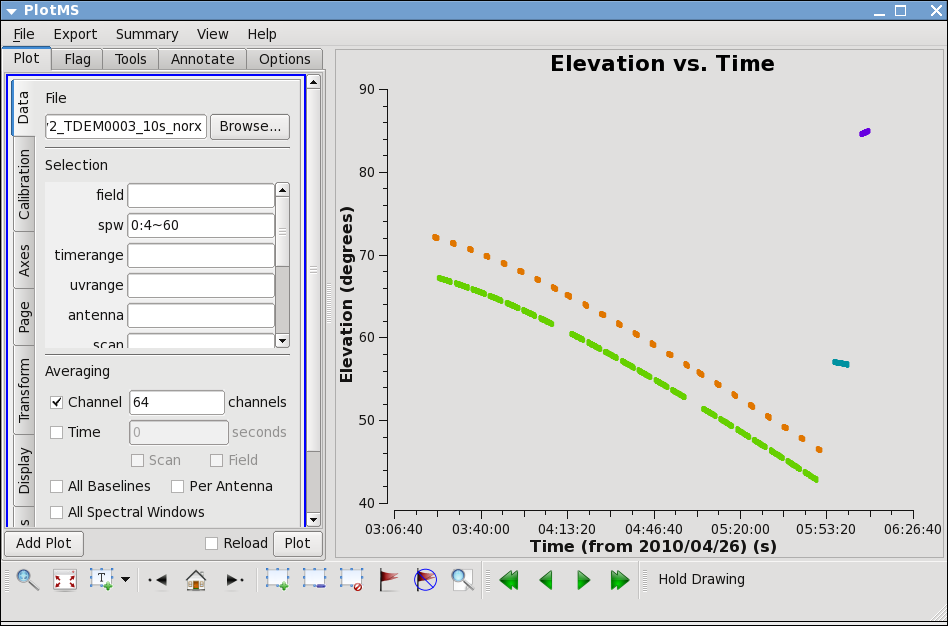
# In CASA
plotants(vis='day2_TDEM0003_10s_norx',figfile='ant_locations.png')
Next, let's look at the elevation as a function of time for all sources. It's not the case for these data, but if the elevation is very low (usually at start or end of track) you may want to flag. Also, how near in elevation your flux calibrator is to your target will impact your ultimate absolute flux calibration accuracy. Unfortunately, the target and flux calibrator are not particularly well-matched for this observation, as you can show by plotting the elevation for each source (each sources has a different colors):
# In CASA
plotms(vis='day2_TDEM0003_10s_norx',
xaxis='time',yaxis='elevation',correlation='RR,LL',
avgchannel='64',spw='0:4~60', coloraxis='field')
Thus we are strongly dependent on the opacity and gaincurve corrections to get the flux scale right for these data. (This is something to keep in mind when planning observations!)
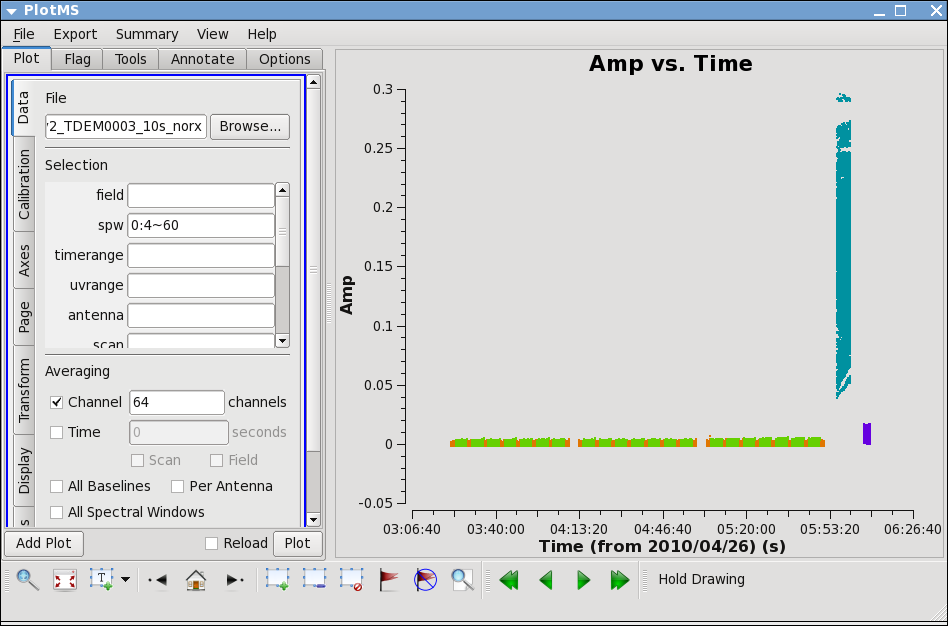
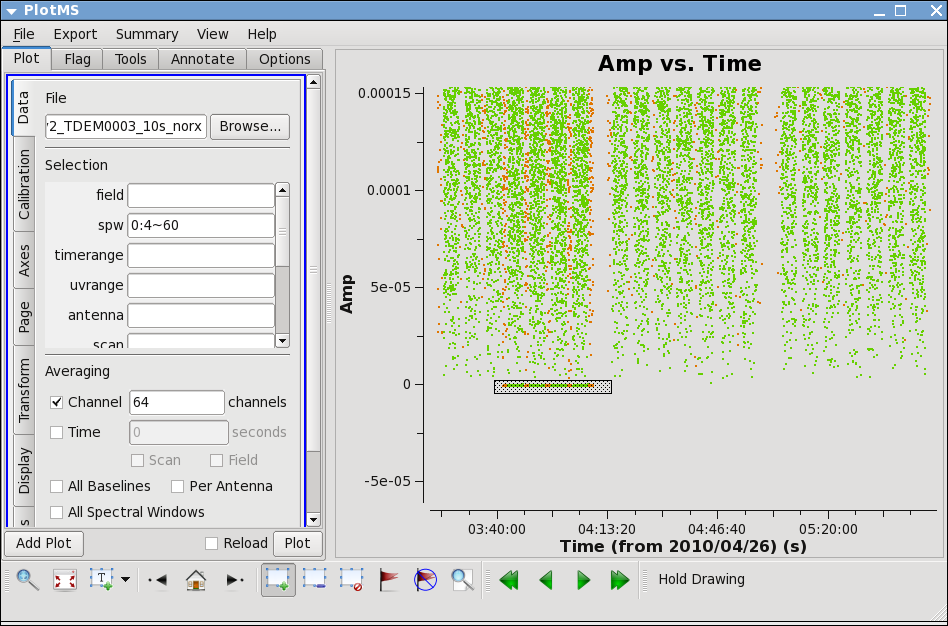
Next, let's look at all the source amplitudes as a function of time.
# In CASA
plotms(vis='day2_TDEM0003_10s_norx',
xaxis='time',yaxis='amp',correlation='RR,LL',
avgchannel='64',spw='0:4~60', coloraxis='field')
Now zoom in on the region very near zero amplitude for sources J0954+1743 and IRC+10216. To zoom, select the
Zoom tool in lower left corner of the plotms GUI, then you can left click to draw a box.
Look for the low values (you may want to zoom a few times to really see the suspect points clearly). Now use the Mark Region and Locate buttons (located along the bottom of the GUI) to see which antenna is causing problems. Since all the "located" baselines include ea12, this is the responsible antenna.
IMPORTANT NOTES ON PLOTMS: * When using the locate button it is important to have only selected a modest number of points with the mark region tool (see example of marked region in the thumnail), otherwise the response will be very slow and possibly hang the tool (all of the information will be output to your terminal window, not the logger). * Throughout the tutorial, when you are done marking/locate use the Clear Regions tool to get rid of the marked box before plotting other things. * After flagdata command flagging, you have to force a complete reload of the cache to look at the same plot again with the new flags applied. To do this change anything in the plotms GUI (the colorize parameter, antenna, spw, anything) and hit the plot button. * If the plotms tool does get hung during a plot try clicking the cancel button on the load progress GUI, and/or if you see a "table locked" message try typing clearstat on the CASA command line. * Occasionally plotms will get into a strange state that you cannot clear from inside. We are working on these issues, but for now, when all else fails, exit from casapy and restart.
Now click the clear region button, and then go back to the zoom button to zoom in further to note exactly what the time range is: 03:41:00~04:10:00.
Check the other sideband by changing spw to 1:4~60. You will have to rezoom. If you have trouble, click on the Mark icon and then back to zoom. In spw=1, ea07 is bad from the beginning until after next pointing run: 03:21:40~04:10:00. To see this, compare the amplitudes when antenna is set to 'ea07' and when it is set to one of the other antennas, such as 'ea08'.
If you set antenna to 'ea12' and zoom in on this intial timerange, you can also see that ea12 is bad during the same time range as for spw 0. You can also see this by entering '!ea07' for antenna, which removes ea07 from the plot (in CASA selection, ! deselects).
We can set up a flagging command to get both bad antennas for the appropriate time and spw:
# In CASA
flagdata(vis='day2_TDEM0003_10s_norx',
field=['2,3','2,3'],
spw=['','1'],
antenna=['ea12','ea07'],
timerange=['03:41:00~04:10:00','03:21:40~04:10:00'])
Note that because the chosen timerange is limited to fields 2 and 3, the field parameter is not really needed; however, flagdata will run fastest if you put as many constraints as possible.
Now remove the !ea07 from antenna and replot both spw, zooming in to be sure that all obviously low points are gone. Also zoom in and check 3C286 (J1229+0203 is already obvious because it is so bright!).
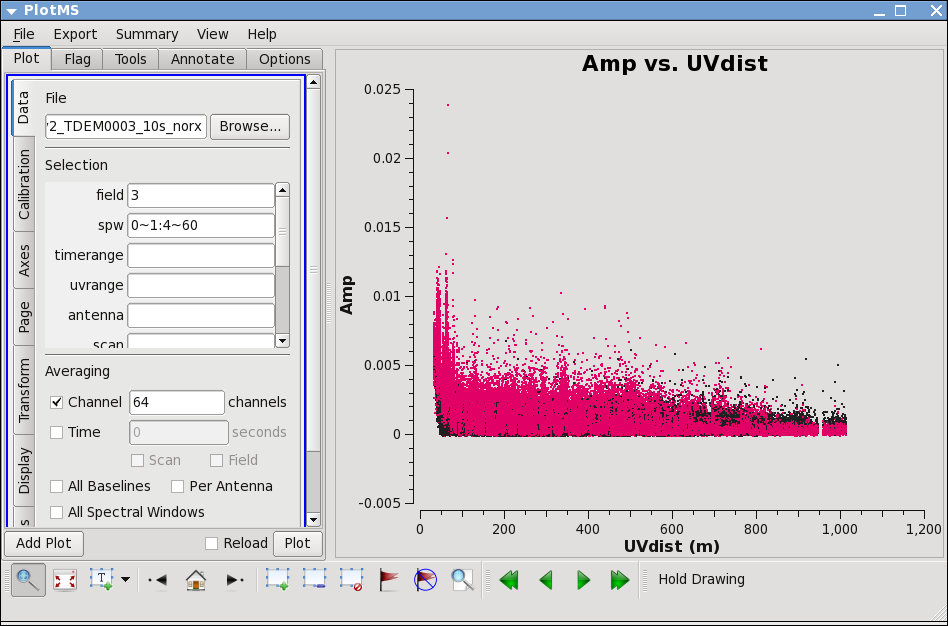
Lets look more closely at IRC+10216:
# In CASA
plotms(vis='day2_TDEM0003_10s_norx',field='3',
xaxis='time',yaxis='amp',correlation='RR,LL',
avgchannel='64',spw='0~1:4~60', coloraxis='spw')
You can see a that there are some noisy high points. But now try
# In CASA
plotms(vis='day2_TDEM0003_10s_norx',field='3',
xaxis='uvdist',yaxis='amp',correlation='RR,LL',
avgchannel='64',spw='0~1:4~60', coloraxis='spw')
Most of the high points on IRC+10216 are due to large scale emission on short baselines, but there is still some noisy stuff -- for a target like this with extended emission it's best to wait until later to decide what to do about it. We will not be able to get adequate calibration for antennas that are truly bad (even if they don't stand out here) so these will be obvious later.
Set Up the Model for the Flux Calibrator
Next, we set the model for the flux calibrator. Depending on your observing frequency and angular resolution you can do this several ways. In the past, one typically used a point source (constant flux) model for the flux calibrator, possibly with a uvrange cutoff if necessary. More recently for the VLA/EVLA, model images for the most common flux calibrators have been made available for use in cases where the sources are somewhat resolved. This is most likely to be true at higher frequencies and at higher resolutions (more extended arrays). Thus below we use the K-band model image for these Ka-band observations. Because one model image is typically available per receiver band (in this case the model for Ka-band is the same as that of K-band), the frequency of the model image probably does not match exactly the frequency of your observations, as is certainly the case here. In that case, the task scales the total flux in the model image to that appropriate for your observing frequency according to the calibrator's flux as a function of frequency model, and reports this number in the logger -- it is a good idea to save this information for your records.
First, we need to locate the model image. The modimage location used in the command is appropriate for running CASA after installing from the 3.0.2 Linux tarball. If you are running elsewhere (Mac for example),
# in a terminal, outside of CASA:
locate 3C286_K.im
to find where the models live (the models are always shipped with CASA). For example at the AOC they are located in /usr/lib64/casapy/data/nrao/VLA/CalModels/ for 64-bit computers. If you have just installed CASA your computer's database may not have updated yet. In that case you will need to look around for them.
Once you have found the path to the file, you need to edit the value of the modimage parameter in setjy below.
# In CASA
setjy(vis='day2_TDEM0003_10s_norx',field='7',spw='0~1',
modimage='/usr/lib64/casapy/data/nrao/VLA/CalModels/3C286_K.im')
The logger output for each spw is: setjy J1331+3030 spwid= 0 [I=1.776, Q=0, U=0, V=0] Jy, (Perley-Butler 2010) setjy J1331+3030 spwid= 1 [I=1.779, Q=0, U=0, V=0] Jy, (Perley-Butler 2010)
Bandpass
Before determining the bandpass solution, we need to inspect phase and amplitude variations with time and frequency on the bandpass calibrator to decide how best to proceed. We limit the number of antennas to make the plot easier to see. We chose ea02 as it seems like a good candidate for the reference antenna.
# In CASA
plotms(vis='day2_TDEM0003_10s_norx',field='5',
xaxis='channel',yaxis='phase',correlation='RR',
avgtime='1e8',spw='0:4~60',antenna='ea02&ea23')
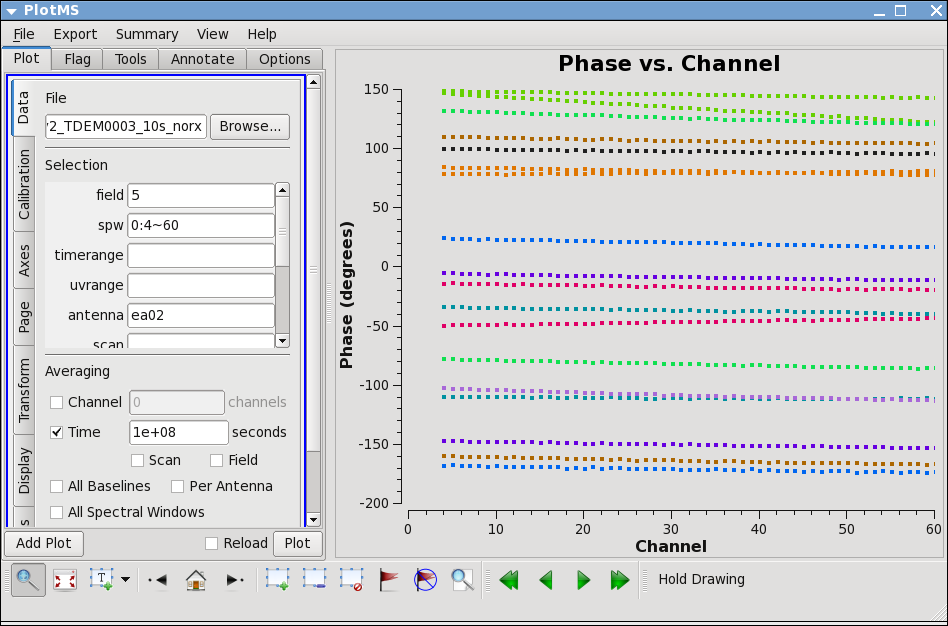
The phase variation is modest ~10 degrees. Now expand to all baselines that include ea02, then hit the "Plot" button.
# In CASA
plotms(vis='day2_TDEM0003_10s_norx',field='5',
xaxis='channel',yaxis='phase',correlation='RR',
avgtime='1e8',spw='0:4~60',antenna='ea02', coloraxis='antenna2')
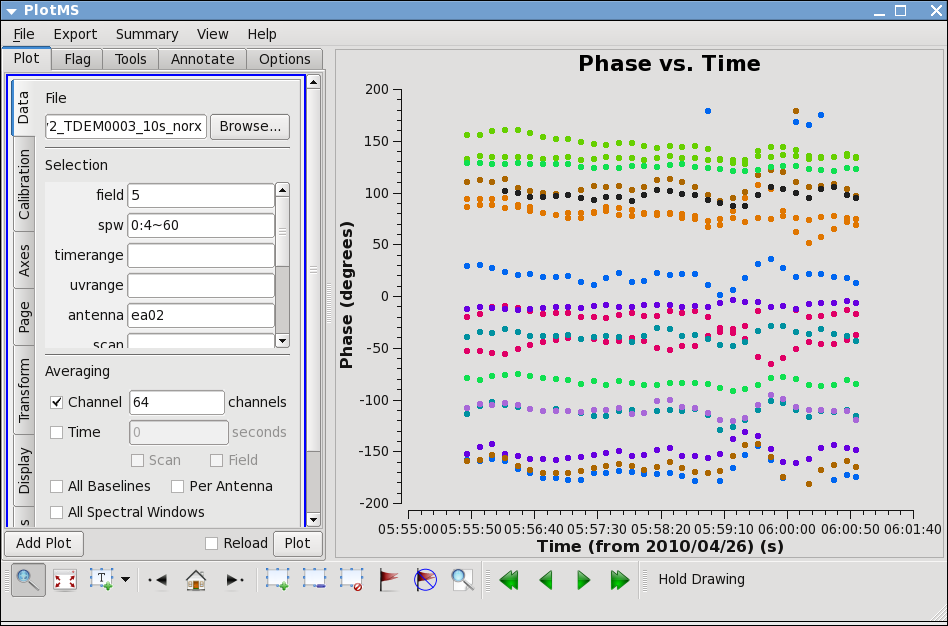
From this you can see that the phase variation across the bandpass is modest. Next check LL, and spw=1, both correlations. Also check other antennas if you like.
Now look at the phase as a function of time.
# In CASA
plotms(vis='day2_TDEM0003_10s_norx',field='5',
xaxis='time',yaxis='phase',correlation='RR',
avgchannel='64',spw='0:4~60',antenna='ea02&ea23')
Expand to all antennas with ea02
# In CASA
plotms(vis='day2_TDEM0003_10s_norx',field='5',
xaxis='time',yaxis='phase',correlation='RR',
avgchannel='64',spw='0:4~60',antenna='ea02', coloraxis='antenna2')
You may want to select "Custom" under "unflagged points symbol" and then change Style from "2" to "3".
You can see that the phase variations are smooth, but do vary significantly over the 5 minutes of observation -- in most cases by a few 10s of degrees. Zoom in to see this better if you want.
The conclusion from this investigation is that you need to correct the phase variations with time before solving for the bandpass to prevent decorrelation of the vector averaged bandpass solution. Since the phase variation as a function of channel is modest, you can average over several channels to increase the signal to noise of the phase vs. time solution. If the phase variation as a function of channel is larger you may need to use only a few channels to prevent introducing delay-based closure errors as can happen from averaging over non-bandpass corrected channels with large phase variations.
Since the bandpass calibrator is quite strong we do the phase-only
solution on the integration time of 10 seconds (solint='int').
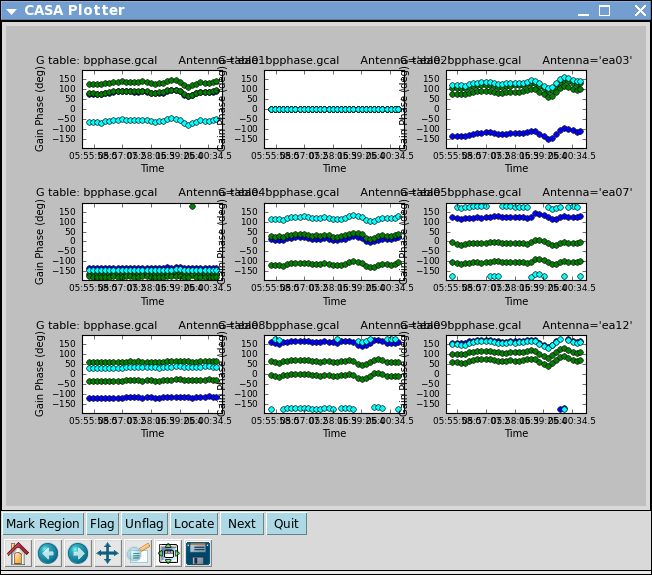
# In CASA
gaincal(vis='day2_TDEM0003_10s_norx',caltable='bpphase.gcal',
field='5',spw='0~1:20~40',
refant='ea02',calmode='p',solint='int',minsnr=2.0,
gaintable=['antpos.cal'],
opacity=0.04,gaincurve=T)
Plot the solutions
# In CASA
plotcal(caltable='bpphase.gcal',xaxis='time',yaxis='phase',
iteration='antenna',subplot=331,plotrange=[0,0,-180,180])
These solutions will appear in the CASA plotter gui. If you closed it after plotting the antennas above, it should reopen. If it is still open from before, the new plots should just appear. After you are done looking at the first set of plots, push the "Next" button on the GUI to see the next set of antennas.
Next we can apply this phase solution on the fly while determining the bandpass solutions on the timescale of the bandpass calibrator scan (solint='inf').
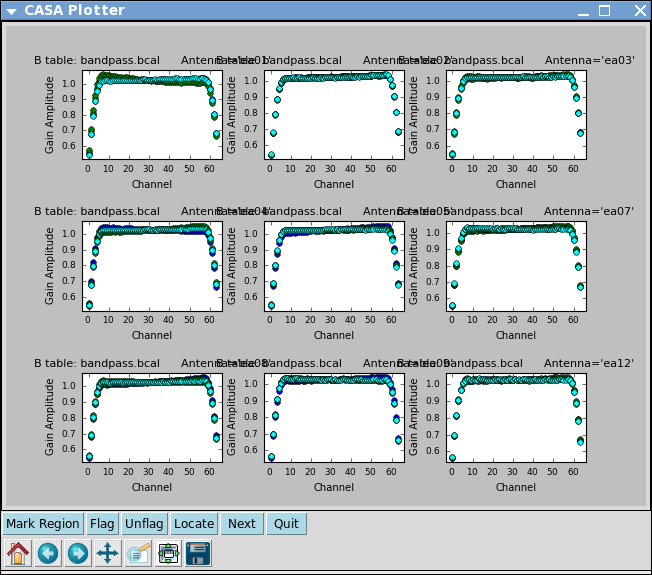
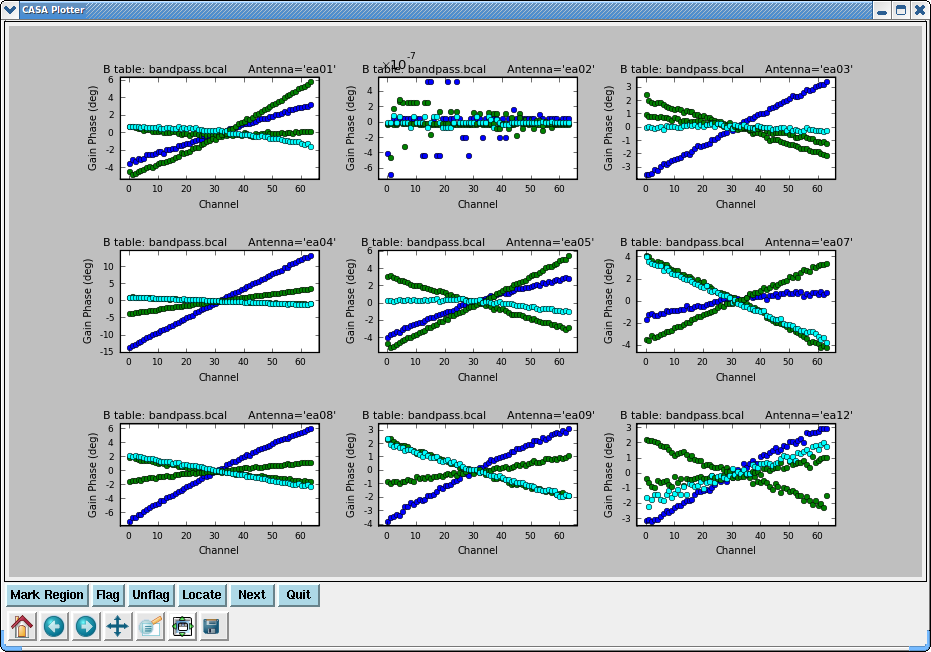
# In CASA
bandpass(vis='day2_TDEM0003_10s_norx',caltable='bandpass.bcal',field='5',
refant='ea02',solint='inf',solnorm=T,
gaintable=['antpos.cal','bpphase.gcal'],
opacity=0.04,gaincurve=T)
A few words about solint and combine:
The use of solint='inf' in bandpass will derive one bandpass solution for the whole J1229+0203 scan. Note that if there had been two observations of the bandpass calibrator (for example), this command would have combined the data from both scans to form one bandpass solution, because the default of the combine parameter for bandpass is combine='scan'. To solve for one bandpass for each bandpass calibrator scan you would also need to include combine=' ' in the bandpass call. In all calibration tasks, regardless of solint, scan boundaries are only crossed when combine='scan'. Likewise, field (spw) boundaries are only crossed if combine='field' (combine='spw'), the latter two are not generally good ideas for bandpass solutions.
Plot the solutions, amplitude and phase:
# In CASA
plotcal(caltable='bandpass.bcal',xaxis='chan',yaxis='amp',
iteration='antenna',subplot=331)
# In CASA
plotcal(caltable='bandpass.bcal',xaxis='chan',yaxis='phase',
iteration='antenna',subplot=331)
Note that phases on ea12 look noiser than on other antennas. This jitter could indicate bad pointing; note that ea12 had just come back in the array.
This step isn't necessary from a calibration perspective, but if you want to go ahead and check the bandpass calibration on the bandpass calibrator you can run applycal here. In future we hope to plot corrected data on-the-fly without this applycal step. Later applycals will overwrite this one, so no need to worry.
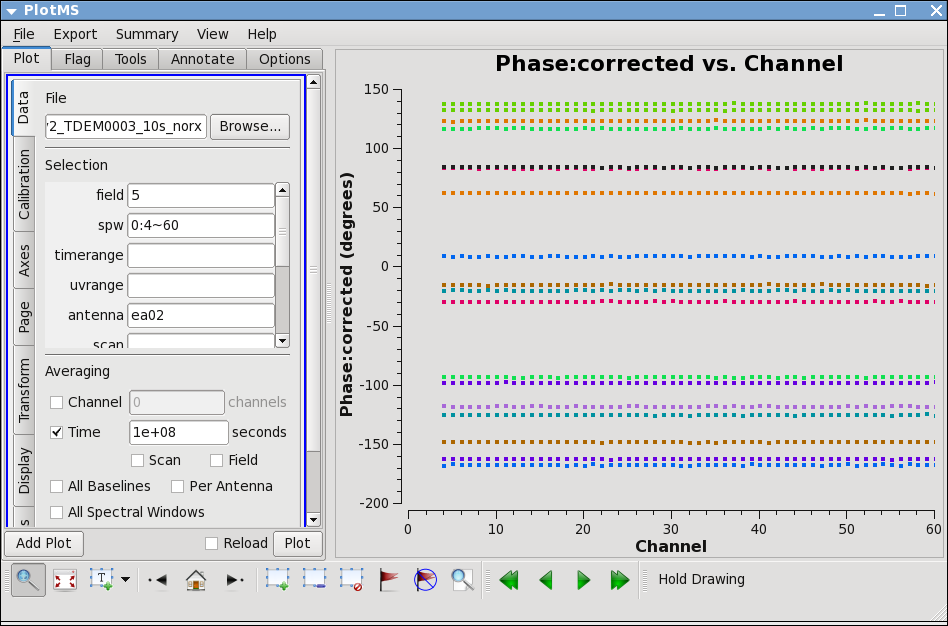
applycal(vis='day2_TDEM0003_10s_norx',field='5',
gaintable=['antpos.cal','bandpass.bcal'],
gainfield=['','5'],
opacity=0.04,gaincurve=T,calwt=F)
plotms(vis='day2_TDEM0003_10s_norx',field='5',
xaxis='channel',yaxis='phase',ydatacolumn='corrected',
correlation='RR',
avgtime='1e8',spw='0:4~60',antenna='ea02', coloraxis='antenna2')
plotms(vis='day2_TDEM0003_10s_norx',field='5',
xaxis='channel',yaxis='amp',ydatacolumn='corrected',
correlation='RR',
avgtime='1e8',spw='0:4~60',antenna='ea02', coloraxis='antenna2')
Note that the phase and amplitude as a function of channel are very flat now.
Gain Calibration
Now that we have a bandpass solution to apply we can solve for the antenna-based phase and amplitude gain calibration. Since the phase changes on a much shorter timescale than the amplitude, we will solve for them separately. In particular, if the phase changes significantly over a scan time, the amplitude would be decorrelated, if the un-corrected phase were averaged over this timescale. Note that we re-solve for the gain solutions of the bandpass calibrator, so we can derive new solutions that are corrected for the bandpass shape. Since the bandpass calibrator will not be used again, this is not strictly necessary, but is useful to check its calibrated flux density for example.
# In CASA
gaincal(vis='day2_TDEM0003_10s_norx',caltable='intphase.gcal',
field='2,5,7',spw='0~1:4~60',
refant='ea02',calmode='p',solint='int',minsnr=2.0,
gaintable=['antpos.cal','bandpass.bcal'],
opacity=0.04,gaincurve=T)
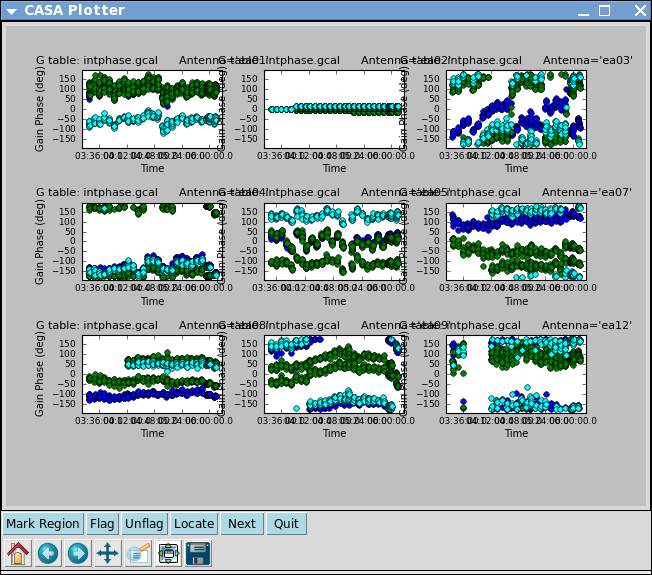
Here solint='int' coupled with calmode='p' will derive a single phase solution for each 10 second integration. Note that the bandpass table is applied on-the-fly before solving for the phase solutions, however the bandpass is NOT applied to the data permanently until applycal is run later on.
Note that quite a few solutions are rejected due to SNR<2 (printed to terminal). For the most part it is only one or two solutions out of >30 so this isn't too worrying. Take note if you see large numbers of rejected solutions per integration. This is likely an indication that solint is too short for the S/N of the data.
Now look at the phase solution, and note the obvious scatter within a scan time.
# In CASA
plotcal(caltable='intphase.gcal',xaxis='time',yaxis='phase',
iteration='antenna',subplot=331,plotrange=[0,0,-180,180])
Although solint='int' (i.e. the integration time of 10 seconds) is the best choice to apply before for solving for the amplitude solutions, it is not a good idea to use this to apply to the target. This is because the phase-scatter within a scan can dominate the interpolation between calibrator scans. Instead, we also solve for the phase on the scan time, solint='inf' (but combine=' ', since we want one solution per scan) for application to the target later on. Unlike the bandpass task, for gaincal, the default of the combine parameter is combine=' '.
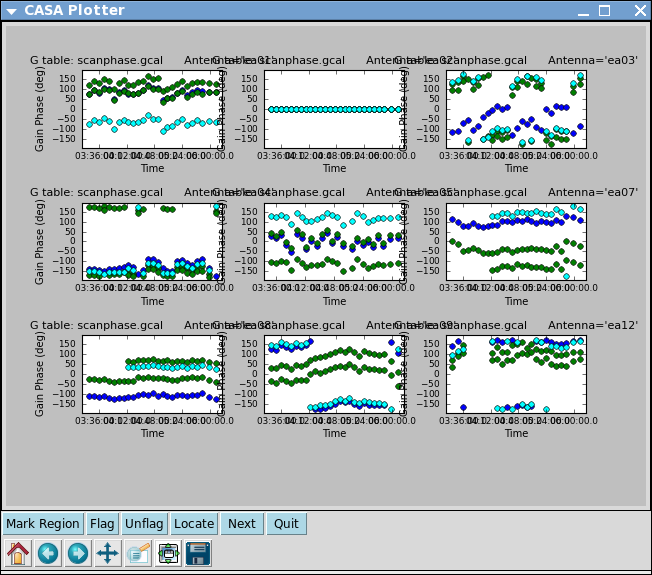
# In CASA
gaincal(vis='day2_TDEM0003_10s_norx',caltable='scanphase.gcal',
field='2,5,7',spw='0~1:4~60',
refant='ea02',calmode='p',solint='inf',minsnr=2.0,
gaintable=['antpos.cal','bandpass.bcal'],
opacity=0.04,gaincurve=T)
# In CASA
plotcal(caltable='scanphase.gcal',xaxis='time',yaxis='phase',
iteration='antenna',subplot=331,plotrange=[0,0,-180,180])
Note that there are no failed solutions here because of the added S/N afforded by the longer solint. Alternatively, instead of making a separate phase solution for application to the target, one can also run smoothcal to smooth the solutions derived on the integration time.
Next we apply the bandpass and solint='int' phase-only calibration solutions on-the-fly to derive amplitude solutions. Here the use of solint='inf', but combine=' ' will result in one solution per scan interval.
# In CASA
gaincal(vis='day2_TDEM0003_10s_norx',caltable='amp.gcal',
field='2,5,7',spw='0~1:4~60',
refant='ea02',calmode='ap',solint='inf',minsnr=2.0,
gaintable=['antpos.cal','bandpass.bcal','intphase.gcal'],
opacity=0.04,gaincurve=T)
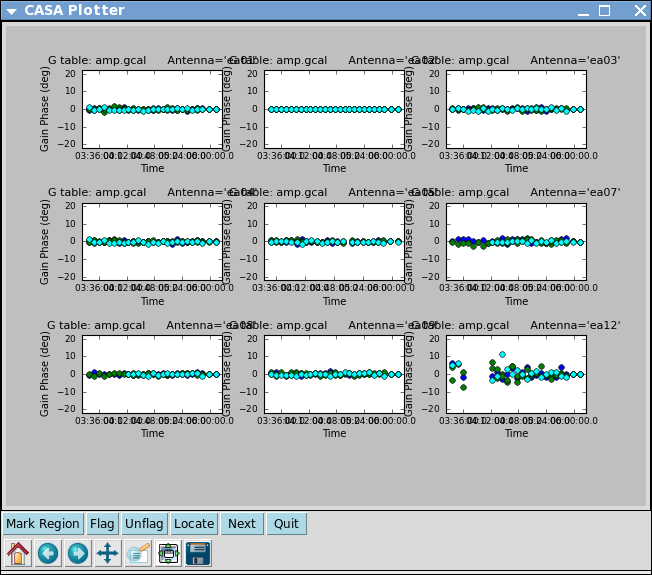
Now let's look at the resulting phase solutions. Since we have taken out the phase as best we can by applying the solint='int' phase-only solution, this plot will give a good idea of the residual phase error. If you see scatter of more than a few degrees here, you should consider going back and looking for more data to flag, particularly bad timeranges etc.
# In CASA
plotcal(caltable='amp.gcal',xaxis='time',yaxis='phase',
iteration='antenna',subplot=331)
Indeed, both antenna ea12 (all times) and ea23 (first 1/3 of observation) show particularly large residual phase noise.
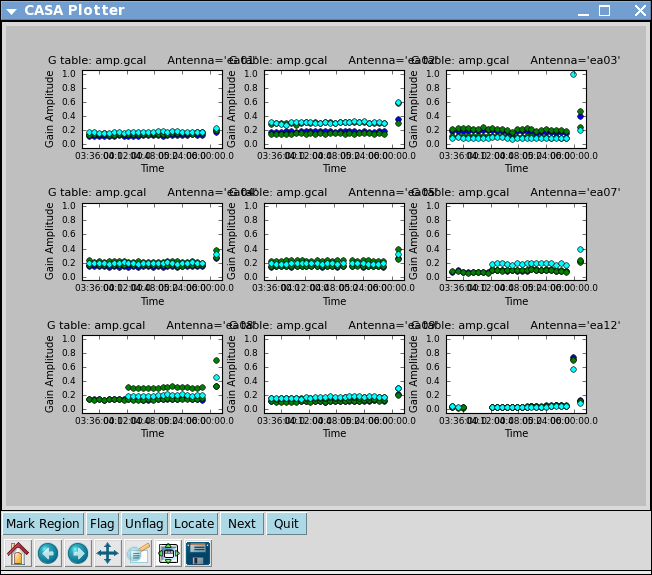
# In CASA
plotcal(caltable='amp.gcal',xaxis='time',yaxis='amp',
iteration='antenna',subplot=331)
Note that the amplitude solutions for ea12 are very low; this is another indication that this antenna is dubious.
Next we use the flux calibrator (whose flux density was set in setjy above) to derive the flux of the other calibrators. Note that the flux table REPLACES the amp.gcal in terms of future application of the calibration to the data, i.e. the flux table contains both the amp.gcal and flux scaling. Unlike the gain calibration steps, this is not an incremental table.
# In CASA
fluxscale(vis='day2_TDEM0003_10s_norx',caltable='amp.gcal',
fluxtable='flux.cal',reference='7')
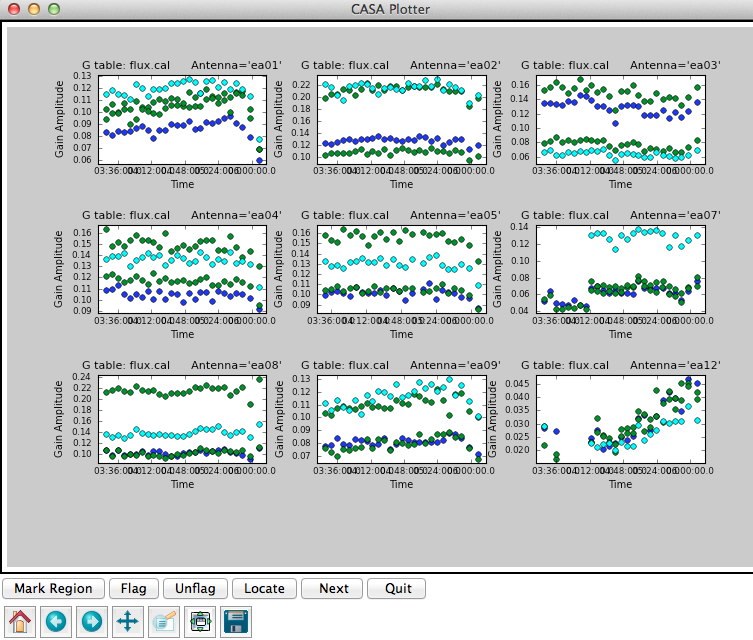
It is a good idea to note down for your records the derived flux densities:
Flux density for J0954+1743 in SpW=0 is: 0.237135 +/- 0.000858511 (SNR = 276.216, nAnt= 19) Flux density for J0954+1743 in SpW=1 is: 0.247597 +/- 0.00063498 (SNR = 389.928, nAnt= 19) Flux density for J1229+0203 in SpW=0 is: 26.508 +/- 0 (SNR = inf, nAnt= 19) Flux density for J1229+0203 in SpW=1 is: 26.2517 +/- 0 (SNR = inf, nAnt= 19)
Obviously, the signal-to-noise for J1229+0203 can't be infinity! This is just an indication that there is only one scan for this source, and we derived a scan based amplitude solution, so there is no variation to calculate.
Next, check that the flux.cal table looks as expected.
# In CASA
plotcal(caltable='flux.cal',xaxis='time',yaxis='amp',
iteration='antenna',subplot=331)
Applycal and Inspect
Now we apply the calibration to each source, according to which tables are appropriate, and which source should be used to do that particular calibration. For the calibrators, all bandpass solutions come from the bandpass calibrator (id=5), and the phase and amplitude calibration comes from their own solutions.
Note: In applycal we set calwt=F. It is very important to turn off this parameter which determines if the weights are calibrated along with the data. Data from antennas with better receiver performance and/or longer integration times should have higher weights, and it can be advantageous to factor this information into the calibration. During the VLA era, meaningful weights were available for each visibility. However, EVLA is not yet recording the information necessary to calculate meaningful weights. Since these data weights are used at the imaging stage you can get strange results from having calwt=T when the input weights are themselves not meaningful, especially for self-calibration on resolved sources (your flux calibrator and target for example). In a few months EVLA data will again have meaningful weights and the default calwt=T will likely again be the best option.
# In CASA
applycal(vis='day2_TDEM0003_10s_norx',field='2',
gaintable=['antpos.cal','bandpass.bcal','intphase.gcal','flux.cal'],
gainfield=['','5','2','2'],
opacity=0.04,gaincurve=T,calwt=F)
# In CASA
applycal(vis='day2_TDEM0003_10s_norx',field='5',
gaintable=['antpos.cal','bandpass.bcal','intphase.gcal','flux.cal'],
gainfield=['','5','5','5'],
opacity=0.04,gaincurve=T,calwt=F)
# In CASA
applycal(vis='day2_TDEM0003_10s_norx',field='7',
gaintable=['antpos.cal','bandpass.bcal','intphase.gcal','flux.cal'],
gainfield=['','5','7','7'],
opacity=0.04,gaincurve=T,calwt=F)
For the target we apply the bandpass from id=5, and the calibration from the gain calibrator (id=2):
# In CASA
applycal(vis='day2_TDEM0003_10s_norx',field='3',
gaintable=['antpos.cal','bandpass.bcal','scanphase.gcal','flux.cal'],
gainfield=['','5','2','2'],
opacity=0.04,gaincurve=T,calwt=F)
Now inspect the corrected data:
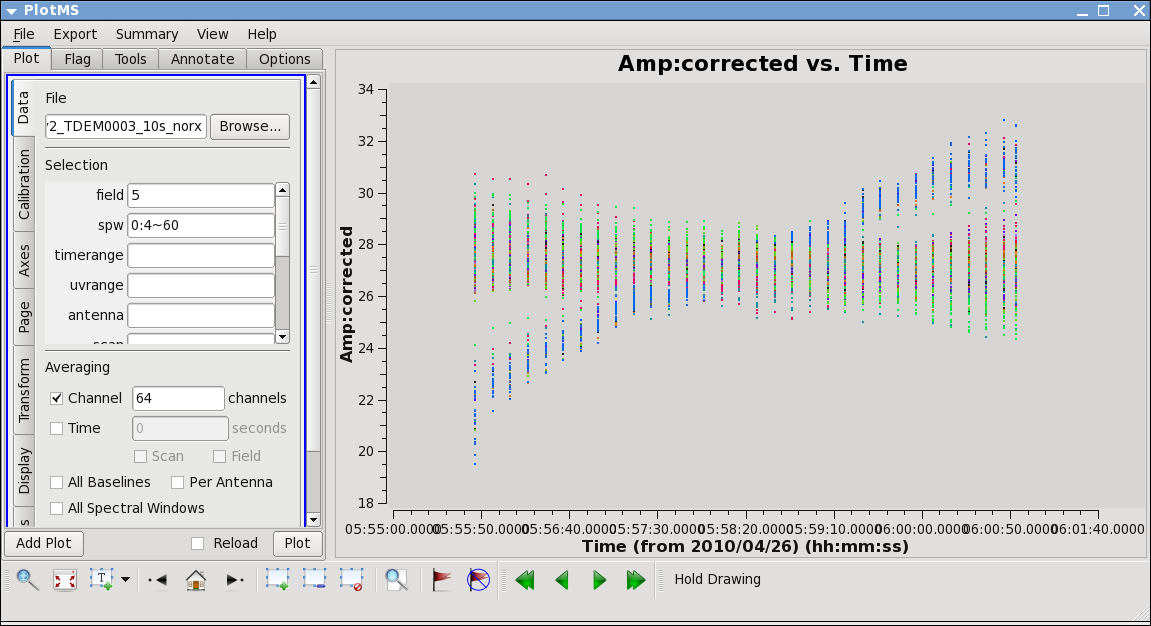
# In CASA
plotms(vis='day2_TDEM0003_10s_norx',field='5',ydatacolumn='corrected',
xaxis='time',yaxis='amp',correlation='RR,LL',
avgchannel='64',spw='0:4~60',antenna='', coloraxis='antenna1')
This plot shows some data deviating from the average amplitudes. Use methods described above to mark a region for a small number of deviant data points, and click "Locate". You will find that ea12 is responsible.
# In CASA
plotms(vis='day2_TDEM0003_10s_norx',field='2',ydatacolumn='corrected',
xaxis='time',yaxis='amp',correlation='RR,LL',
avgchannel='64',spw='0:4~60',antenna='', coloraxis='antenna2')
Here we see some problems, with high points. Mark some regions and locate in plotms to find out which antennas and in which spws. Pay special attention to antennas that have been called out already as showing some dubious behavior.
What you find is that ea07 which we flagged spw=1 above, is also bad for the same timerange in spw=0. This was not obvious in the raw data, because spw=0 was adjusted in the on-line system by a gain attenuator, while spw=1 wasn't. So a lack of power on this antenna can look like very low (and obvious) amplitudes in spw=1 but not for spw=0. Looking carefully you'll see that ea07 is actually pretty noisy throughout.
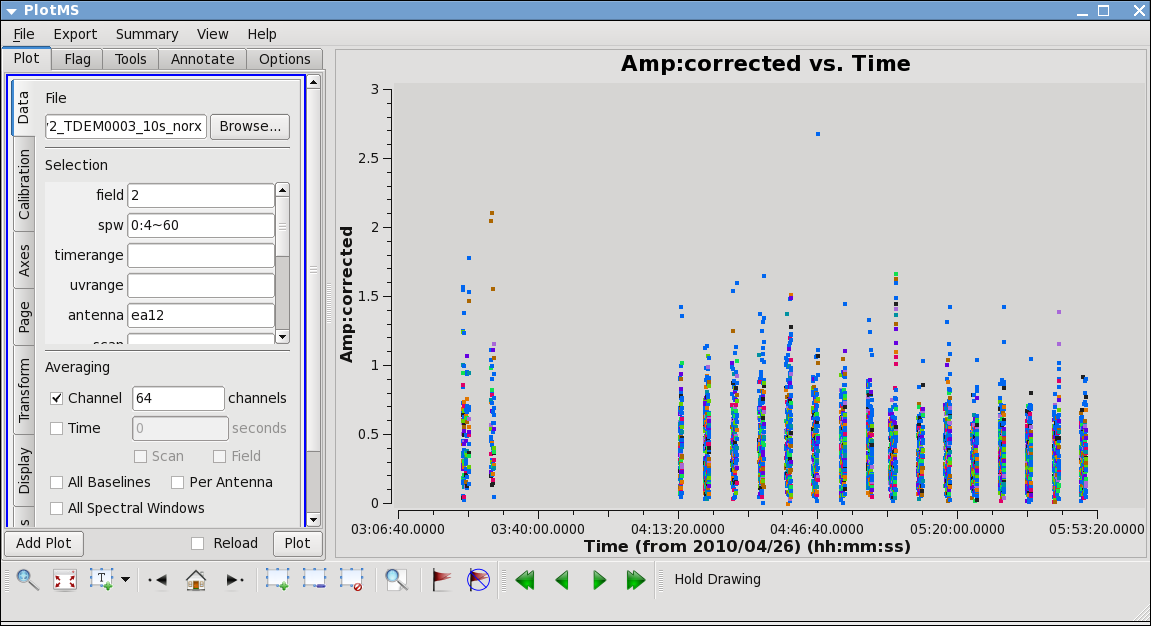
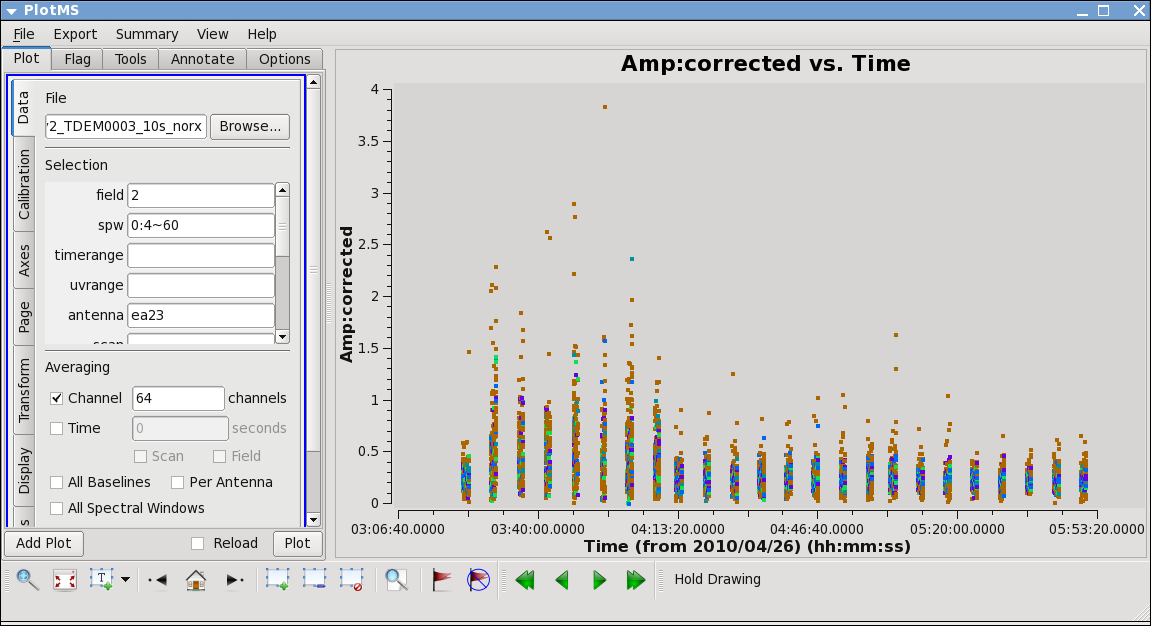
From the locate we also find that ea12 and ea23 show some high points; to see this, replot baselines using each of them alone:
plotms(vis='day2_TDEM0003_10s_norx',field='2',ydatacolumn='corrected',
xaxis='time',yaxis='amp',correlation='RR,LL',
avgchannel='64',spw='0:4~60',antenna='ea12', coloraxis='antenna2')
plotms(vis='day2_TDEM0003_10s_norx',field='2',ydatacolumn='corrected',
xaxis='time',yaxis='amp',correlation='RR,LL',
avgchannel='64',spw='0:4~60',antenna='ea23', coloraxis='antenna2')
ea12 needs to be flagged completely its just a bit noisy all around and ea23 is pretty noisy during the first scans between initial and second pointing. Recall that these are antennas we became suspicious of while inspecting the calibration solutions.
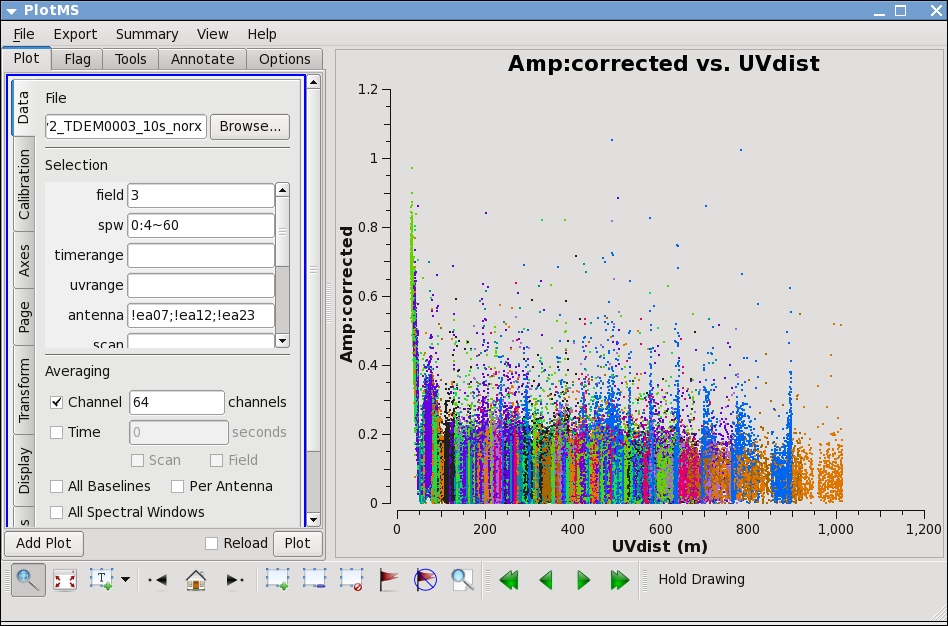
Now lets see how the target looks. Because the target has resolved structure, its best to look at it as a function of uvdistance. We'll go ahead and exclude the three antennas we already know have problems.
# In CASA
plotms(vis='day2_TDEM0003_10s_norx',field='3',ydatacolumn='corrected',
xaxis='uvdist',yaxis='amp',correlation='RR,LL',
avgchannel='64',spw='0:4~60',antenna='!ea07;!ea12;!ea23', coloraxis='antenna2')
you can see that the spikes are caused by a single antenna. Use, zoom, mark, and locate to see which one. Also look at spw=1.
Turns out to be ea28; to confirm, replot with antenna=!ea28, and
# In CASA
plotms(vis='day2_TDEM0003_10s_norx',field='3',ydatacolumn='corrected',
xaxis='uvdist',yaxis='amp',correlation='RR,LL',
avgchannel='64',spw='0:4~60',antenna='!ea07;!ea12;!ea23;!ea28', coloraxis='antenna2')
To see if it's restricted to a certain time
# In CASA
plotms(vis='day2_TDEM0003_10s_norx',field='3',ydatacolumn='corrected',
xaxis='time',yaxis='amp',correlation='RR,LL',
avgchannel='64',spw='0:4~60',antenna='ea28', coloraxis='antenna1')
Baselines with ea28 clearly show issues until about two-thirds of the way through the observation.
Plot another distant antenna to compare. We will go ahead and flag it all, since its hanging far out on the north
arm by itself.
The additional data we've identified as bad need to be flagged, and then all the calibration steps will need to be run again.
# In CASA
flagdata(vis='day2_TDEM0003_10s_norx',
field=['',''],
spw=['',''],
antenna=['ea07,ea12,ea28','ea07,ea23'],
timerange=['','03:21:40~04:10:00'])
Redo Calibration after more Flagging
After flagging, you'll need to repeat the calibration steps above. Here, we append _redo to the table names to distinguish them from the first round, in case we want to compare with previous versions.
# In CASA
gaincal(vis='day2_TDEM0003_10s_norx',caltable='bpphase_redo.gcal',
field='5',spw='0~1:20~40',
refant='ea02',calmode='p',solint='int',minsnr=2.0,
gaintable=['antpos.cal'],
opacity=0.04,gaincurve=T)
# In CASA
bandpass(vis='day2_TDEM0003_10s_norx',caltable='bandpass_redo.bcal',
field='5',
refant='ea02',solint='inf',solnorm=T,
gaintable=['antpos.cal','bpphase_redo.gcal'],
opacity=0.04,gaincurve=T)
# In CASA
gaincal(vis='day2_TDEM0003_10s_norx',caltable='intphase_redo.gcal',
field='2,5,7',spw='0~1:4~60',
refant='ea02',calmode='p',solint='int',minsnr=2.0,
gaintable=['antpos.cal','bandpass_redo.bcal'],
opacity=0.04,gaincurve=T)
# In CASA
gaincal(vis='day2_TDEM0003_10s_norx',caltable='scanphase_redo.gcal',
field='2,5,7',spw='0~1:4~60',
refant='ea02',calmode='p',solint='inf',minsnr=2.0,
gaintable=['antpos.cal','bandpass_redo.bcal'],
opacity=0.04,gaincurve=T)
# In CASA
gaincal(vis='day2_TDEM0003_10s_norx',caltable='amp_redo.gcal',
field='2,5,7',spw='0~1:4~60',
refant='ea02',calmode='ap',solint='inf',minsnr=2.0,
gaintable=['antpos.cal','bandpass_redo.bcal','intphase_redo.gcal'],
opacity=0.04,gaincurve=T)
# In CASA
fluxscale(vis='day2_TDEM0003_10s_norx',caltable='amp_redo.gcal',
fluxtable='flux_redo.cal',reference='7')
Flux density for J0954+1743 in SpW=0 is: 0.235345 +/- 0.000879422
(SNR = 267.613, nAnt= 16)
Flux density for J0954+1743 in SpW=1 is: 0.241996 +/- 0.000930228
(SNR = 260.147, nAnt= 16)
Flux density for J1229+0203 in SpW=0 is: 25.2479 +/- 0
(SNR = inf, nAnt= 16)
Flux density for J1229+0203 in SpW=1 is: 24.9907 +/- 0
(SNR = inf, nAnt= 16)
Flux density for J0954+1743 in SpW=0 is: 0.247052 +/- 0.000946345 (SNR = 261.059, nAnt= 16)
Flux density for J0954+1743 in SpW=1 is: 0.254038 +/- 0.00097531 (SNR = 260.47, nAnt= 16)
Flux density for J1229+0203 in SpW=0 is: 26.5079 +/- 0 (SNR = inf, nAnt= 16)
Flux density for J1229+0203 in SpW=1 is: 26.2335 +/- 0 (SNR = inf, nAnt= 16)
Feel free to pause here and remake the calibration solution plots from above, just be sure to put in the revised table names.
Redo Applycal and Inspect
Now, apply all the new calibrations, which will overwrite the old ones. These commands are identical to those above, with the exception of the _redo part of each calibration filename.
# In CASA
applycal(vis='day2_TDEM0003_10s_norx',field='2',
gaintable=['antpos.cal','bandpass_redo.bcal','intphase_redo.gcal','flux_redo.cal'],
gainfield=['','5','2','2'],
opacity=0.04,gaincurve=T,calwt=F)
# In CASA
applycal(vis='day2_TDEM0003_10s_norx',field='5',
gaintable=['antpos.cal','bandpass_redo.bcal','intphase_redo.gcal','flux_redo.cal'],
gainfield=['','5','5','5'],
opacity=0.04,gaincurve=T,calwt=F)
# In CASA
applycal(vis='day2_TDEM0003_10s_norx',field='7',
gaintable=['antpos.cal','bandpass_redo.bcal','intphase_redo.gcal','flux_redo.cal'],
gainfield=['','5','7','7'],
opacity=0.04,gaincurve=T,calwt=F)
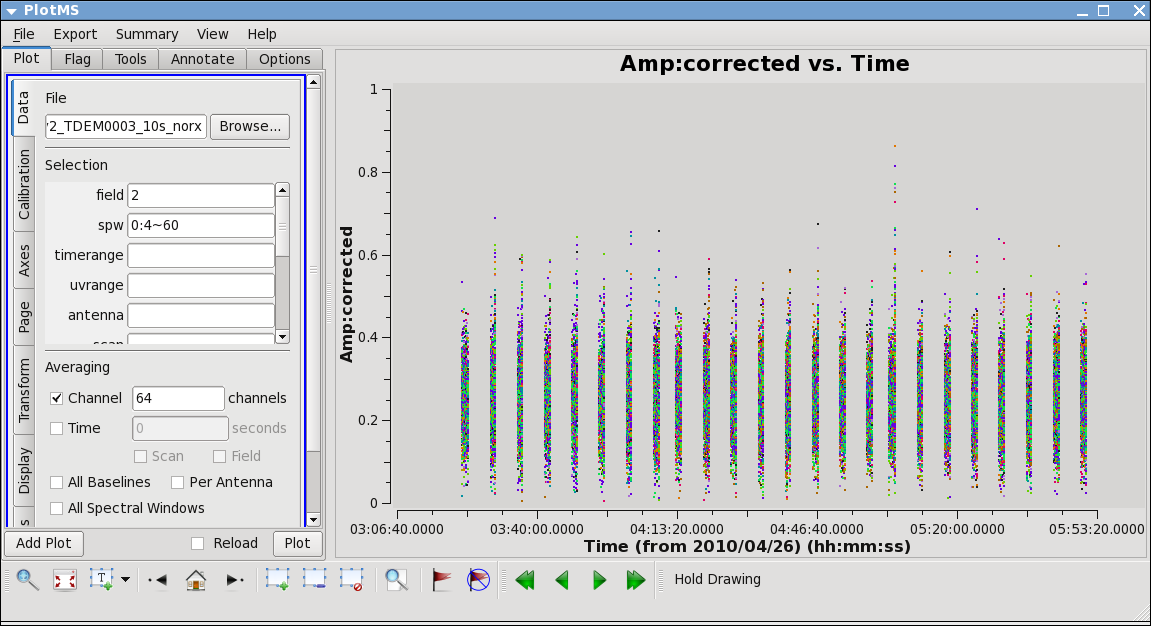
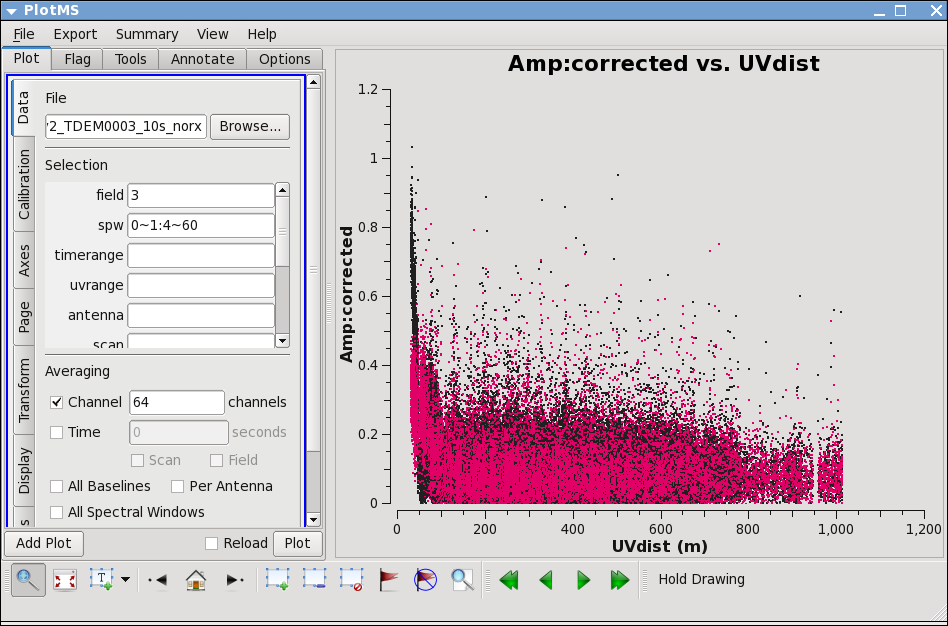
# In CASA
applycal(vis='day2_TDEM0003_10s_norx',field='3',
gaintable=['antpos.cal','bandpass_redo.bcal','scanphase_redo.gcal','flux_redo.cal'],
gainfield=['','5','2','2'],
opacity=0.04,gaincurve=T,calwt=F)
Now you can inspect the calibrated data again. Except for random scatter things look pretty good.
# In CASA
plotms(vis='day2_TDEM0003_10s_norx',field='2',ydatacolumn='corrected',
xaxis='time',yaxis='amp',correlation='RR,LL',
avgchannel='64',spw='0:4~60',antenna='', coloraxis='antenna2')
You can use the Mark and Locate buttons to assess that the remaining scatter seems random, i.e. no particular antenna or time range appears to be responsible.
# In CASA
plotms(vis='day2_TDEM0003_10s_norx',field='3',ydatacolumn='corrected',
xaxis='uvdist',yaxis='amp',correlation='RR,LL',
avgchannel='64',spw='0~1:4~60',antenna='', coloraxis='spw')
Split
Now we split the data into individual files. This is not strictly necessary, as you can select the appropriate fields in later clean stages, but it is safer in case for example you get confused with later processing and want to fall back to this point (this is especially a good idea if you plan to do continuum subtraction or self calibration later on). It also makes smaller individual files in case you want to copy to another machine or colleague.
Here, we split off the data for the phase calibrator and the target:
# In CASA
split(vis='day2_TDEM0003_10s_norx',outputvis='J0954',
field='2')
# In CASA
split(vis='day2_TDEM0003_10s_norx',outputvis='IRC10216',
field='3')
To reinitialize the scratch columns for use by later tasks, we need to run clearcal for both new datasets
# In CASA
clearcal(vis='J0954')
# In CASA
clearcal(vis='IRC10216')
This concludes the calibration phase of the data reductions. The tutorial continues with continuum subtraction, imaging, and image analysis in EVLA Spectral Line Imaging Analysis IRC+10216.
Last checked on CASA Version 3.2.0.